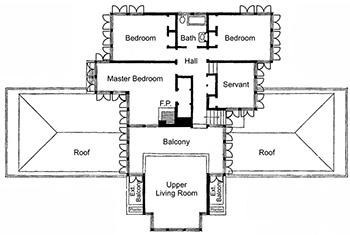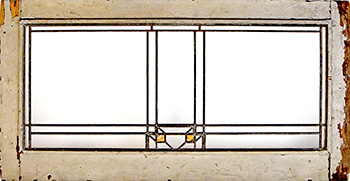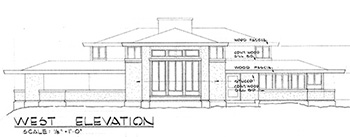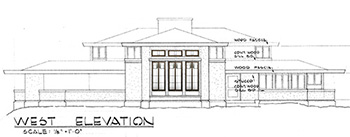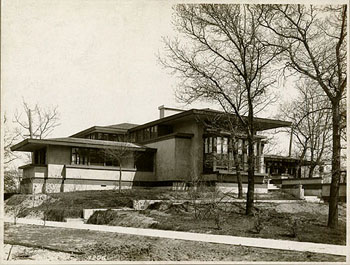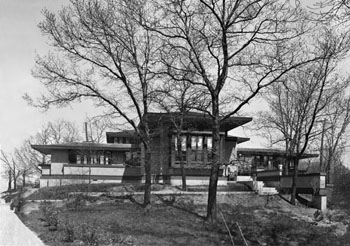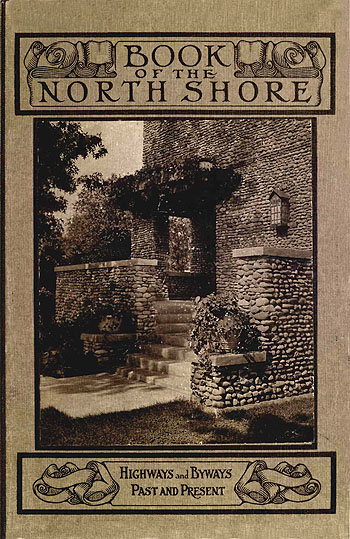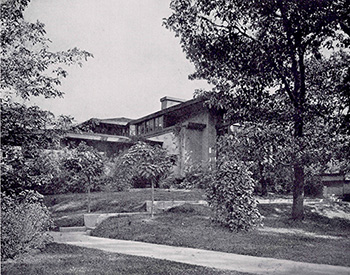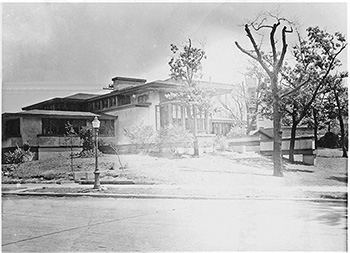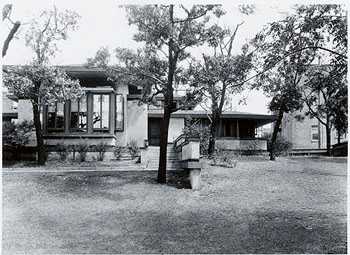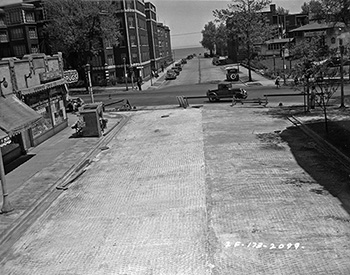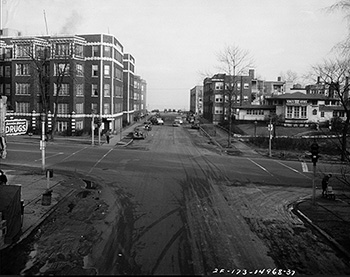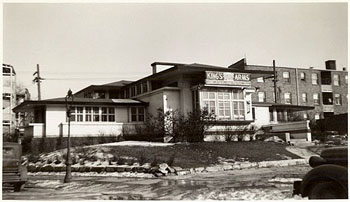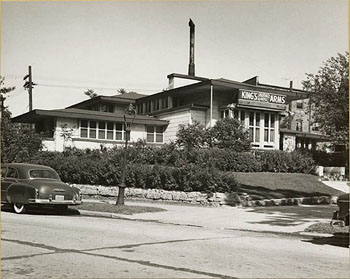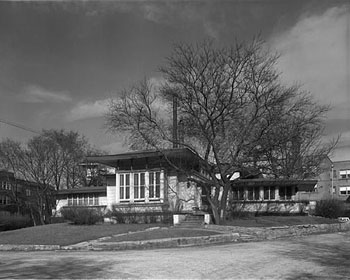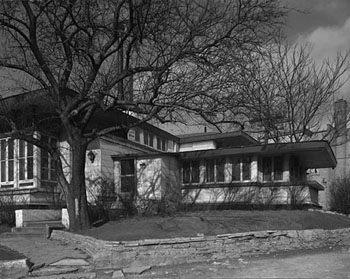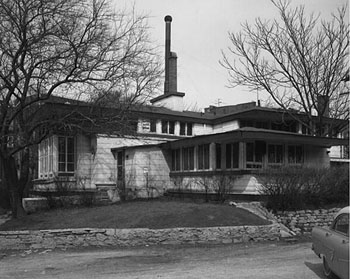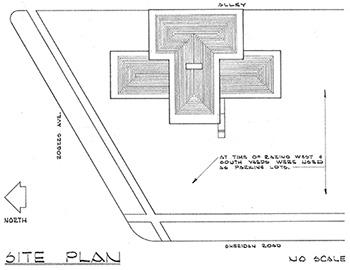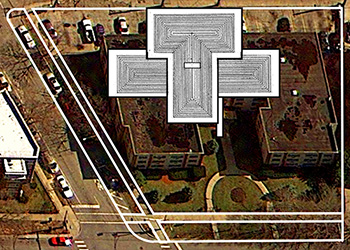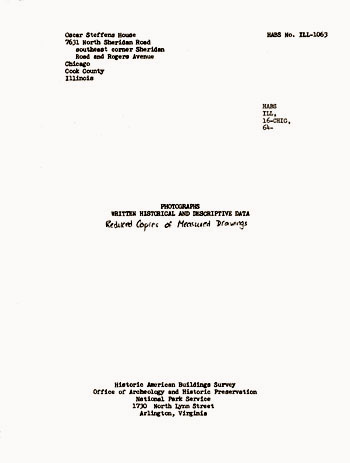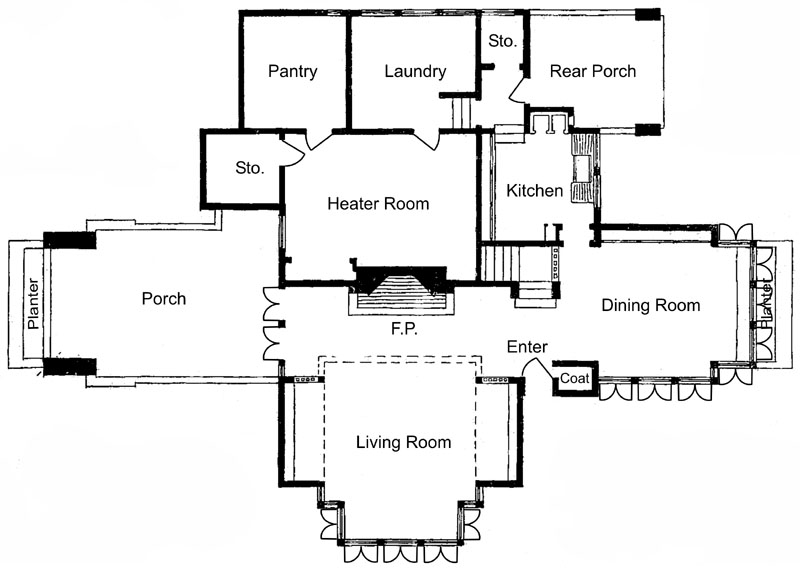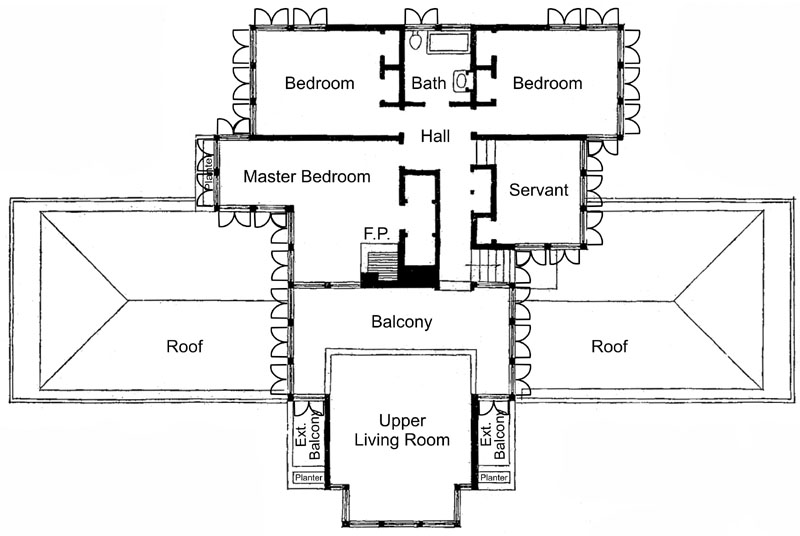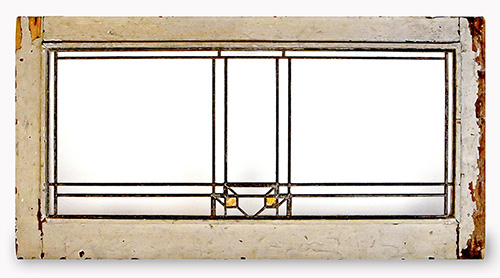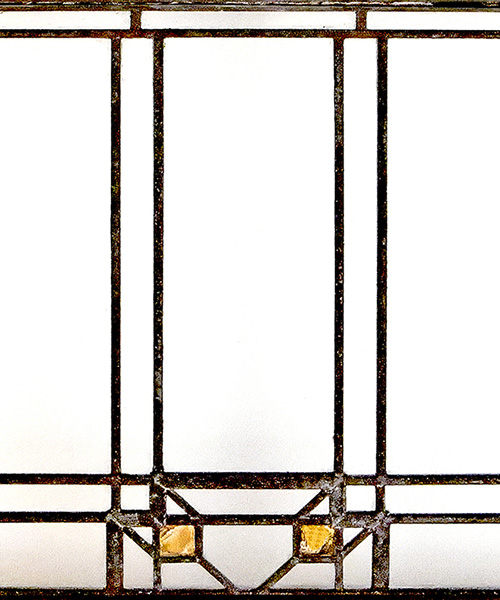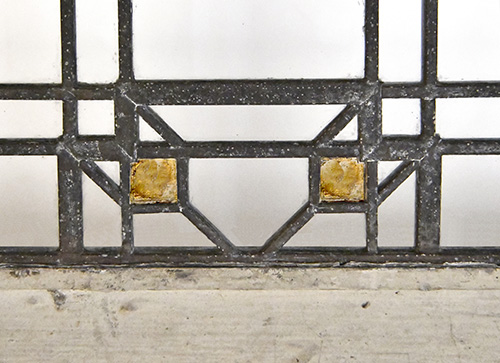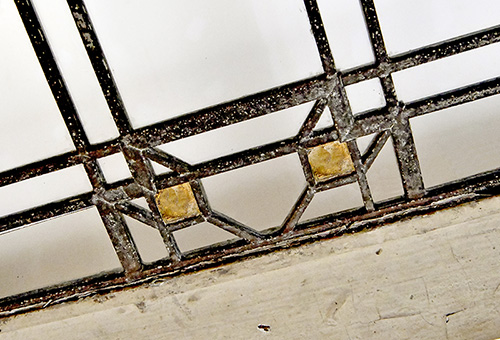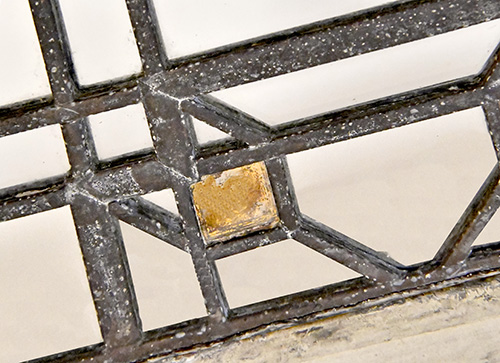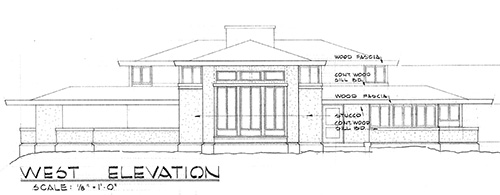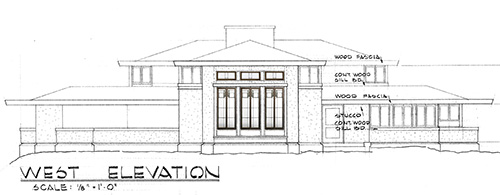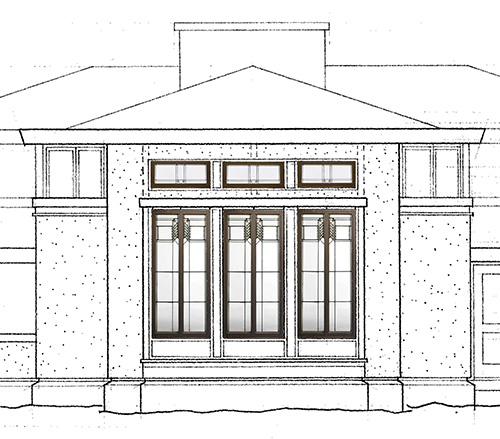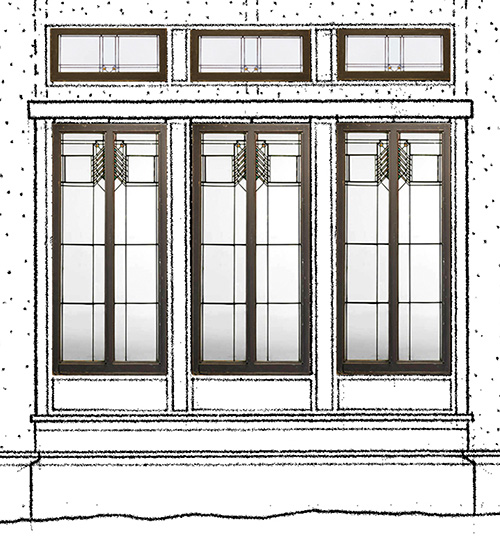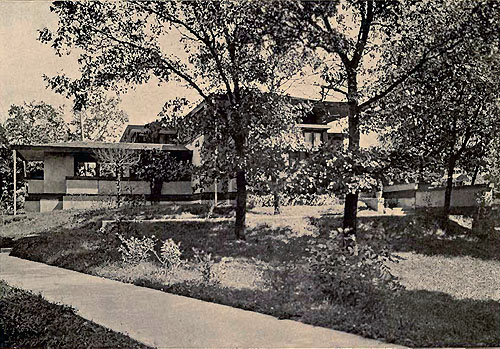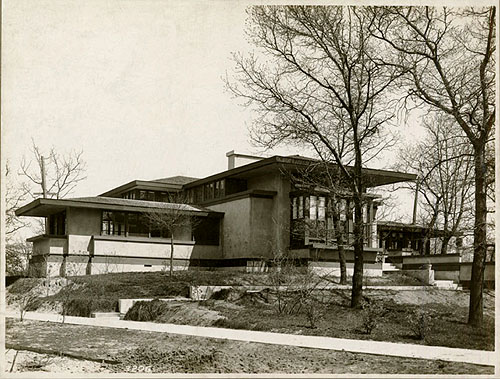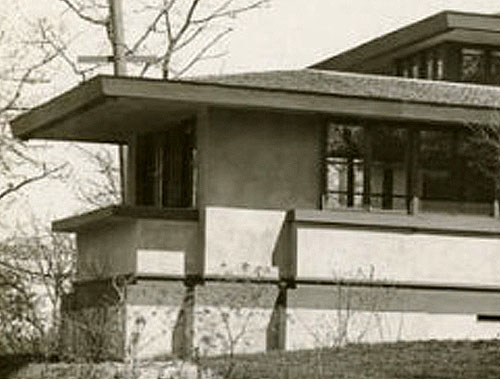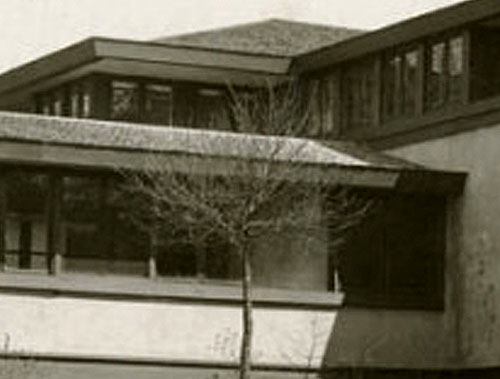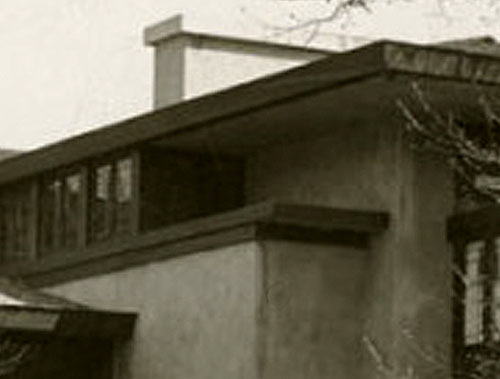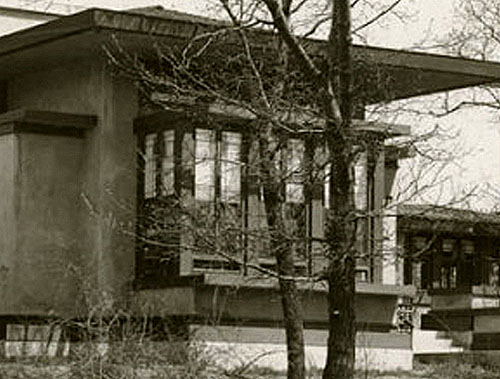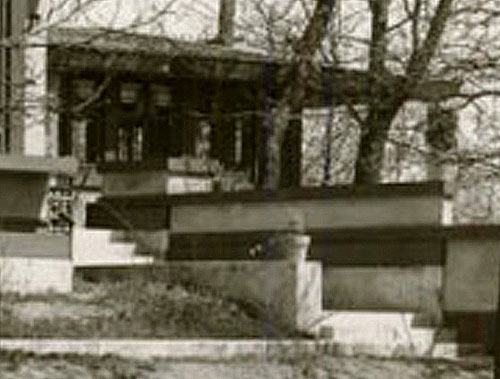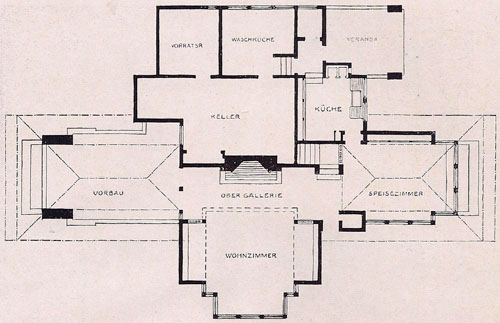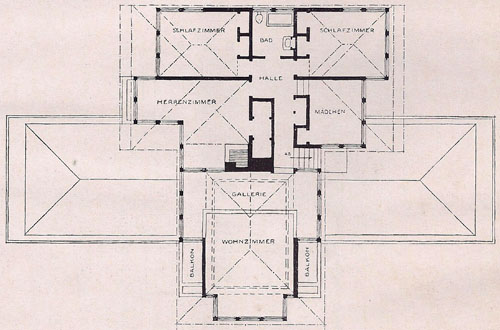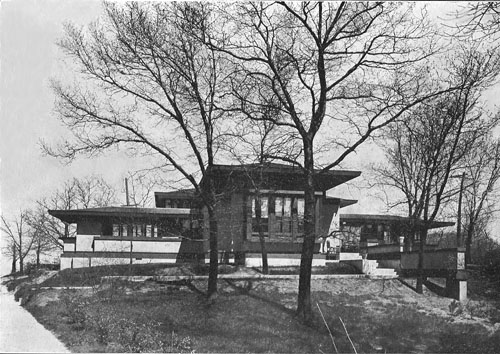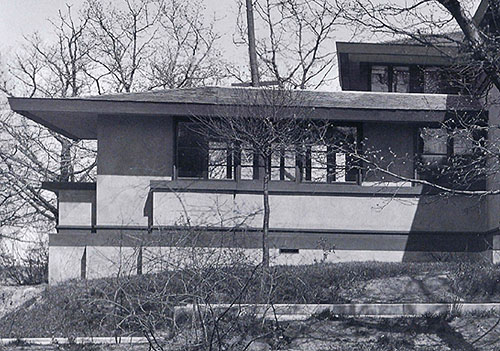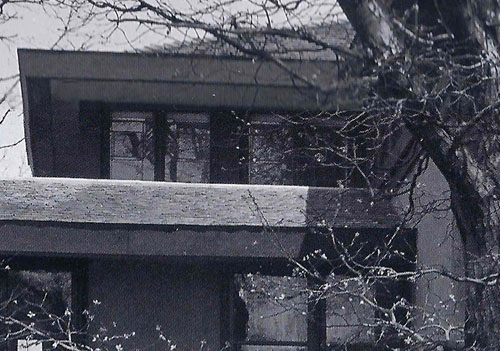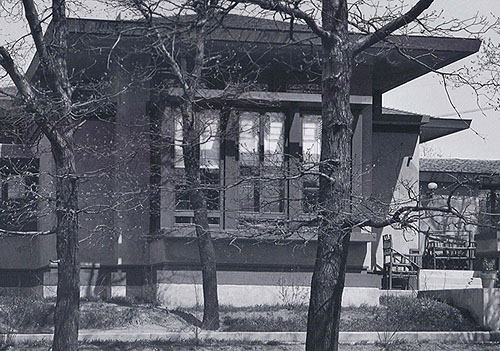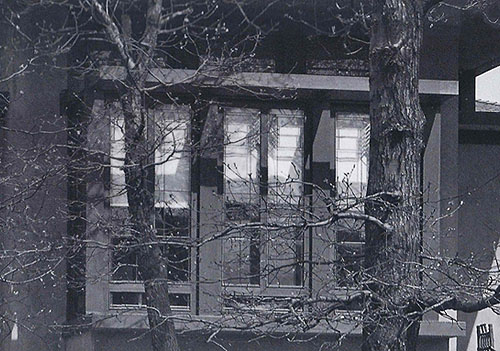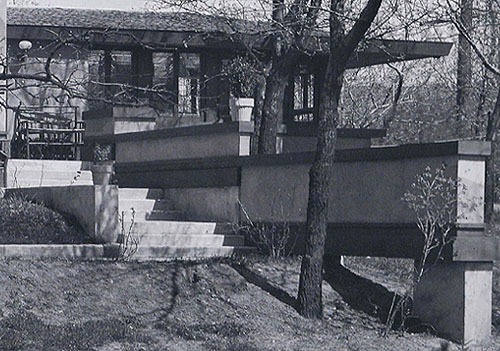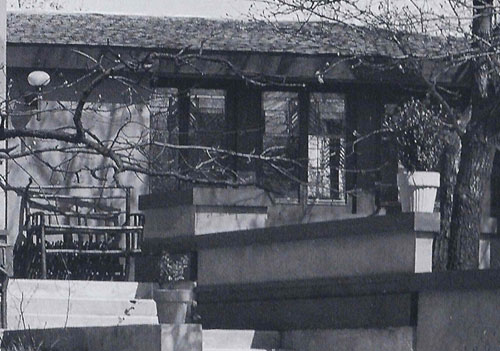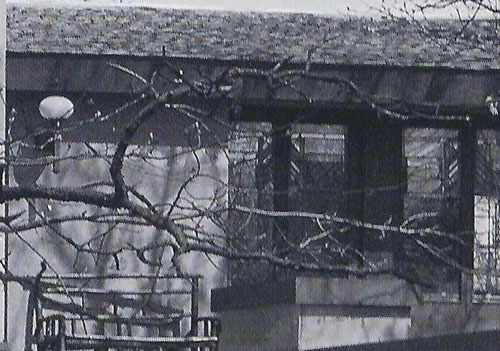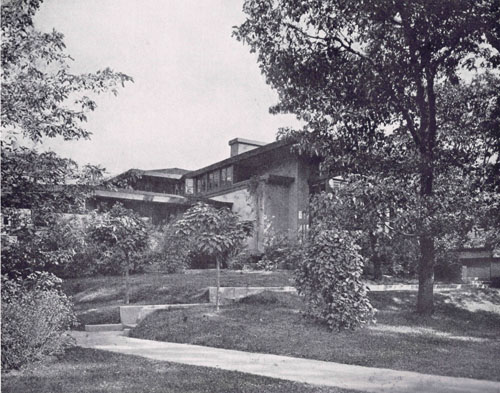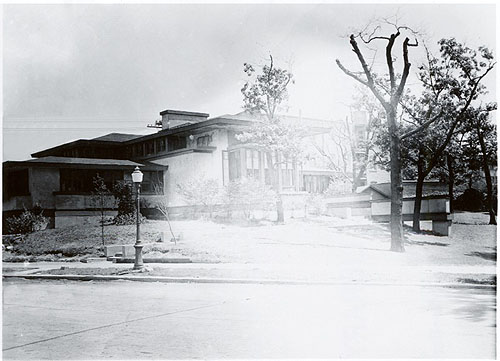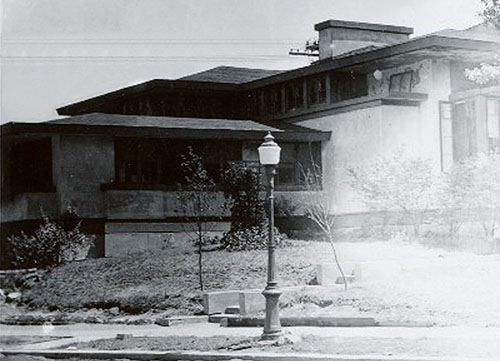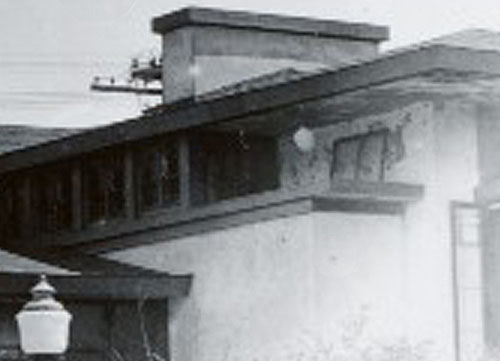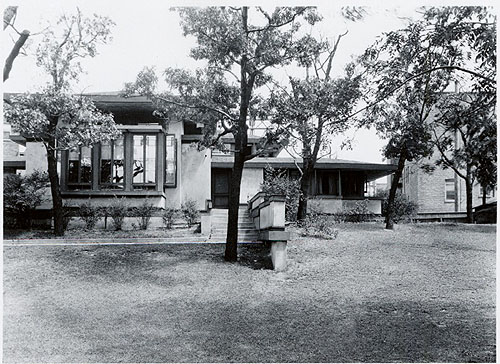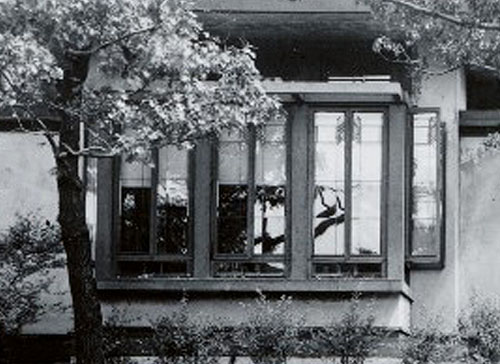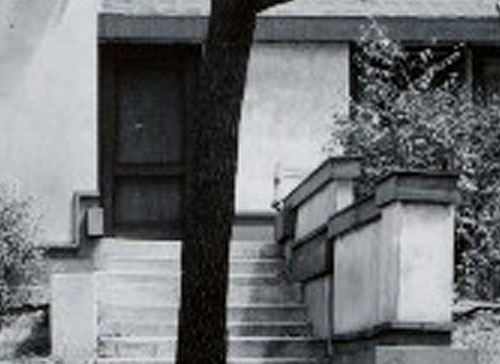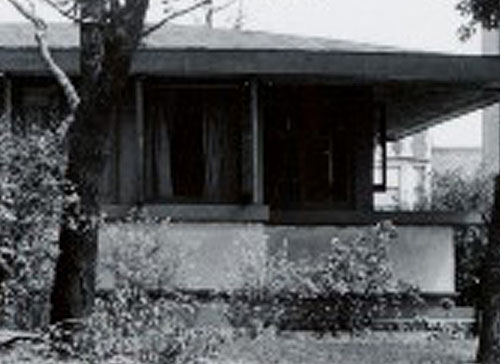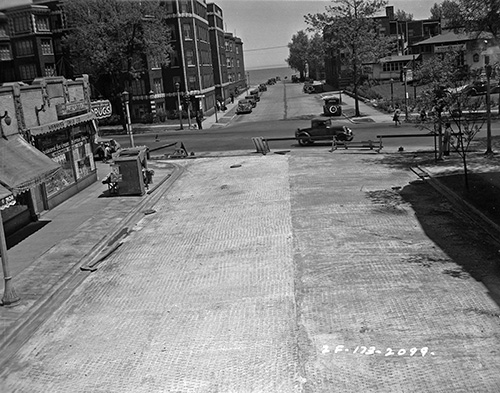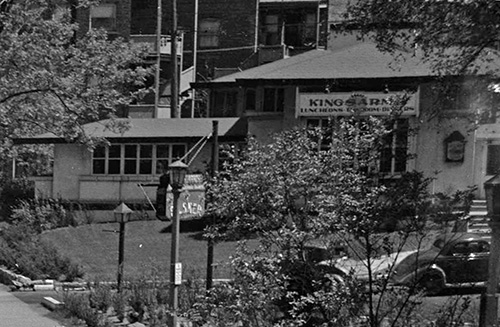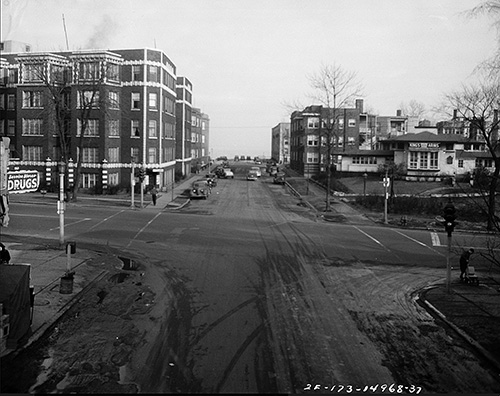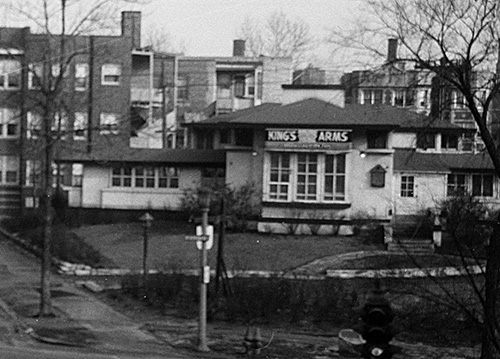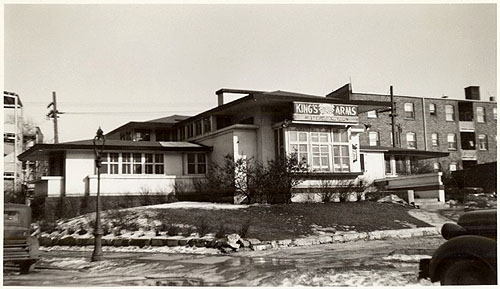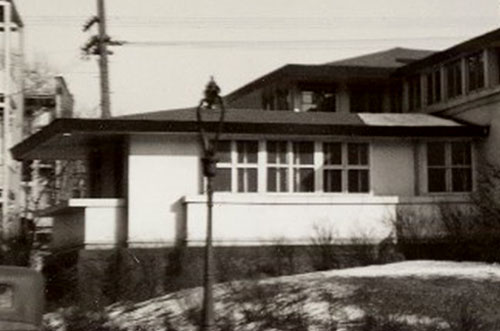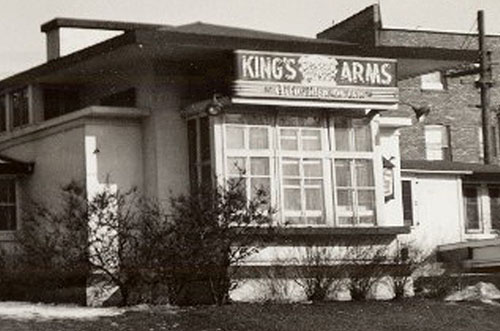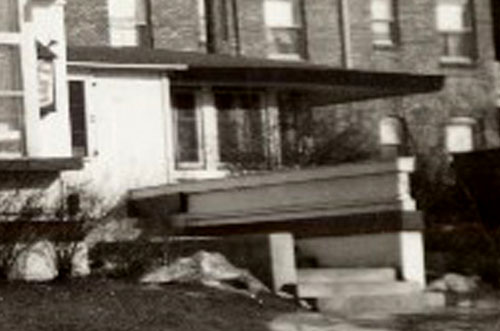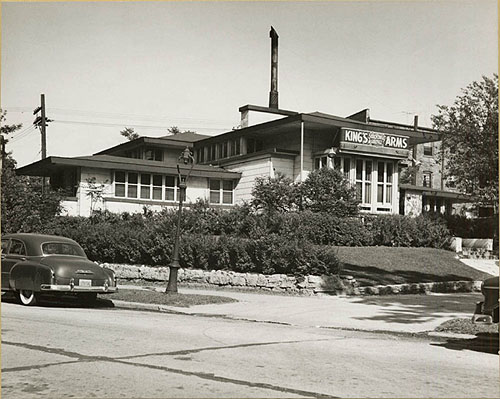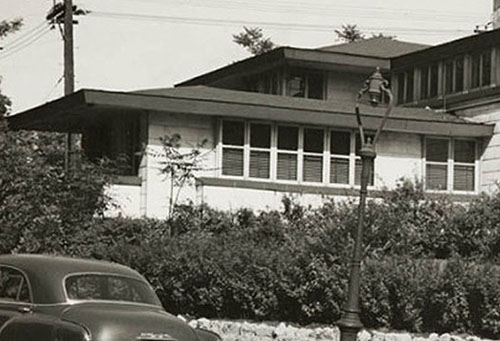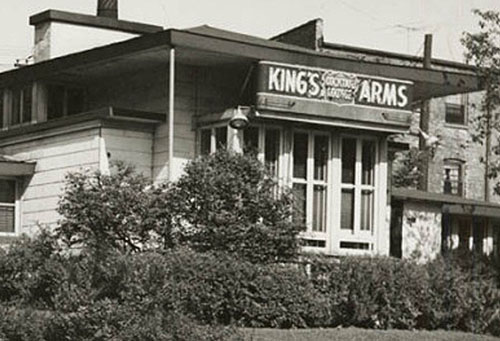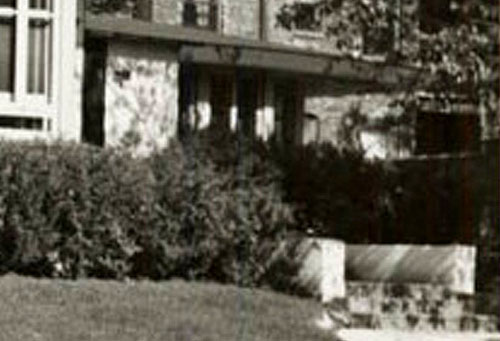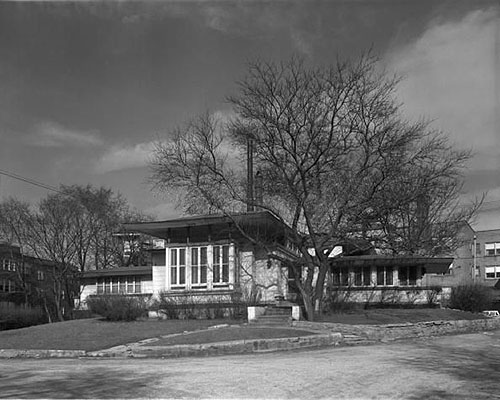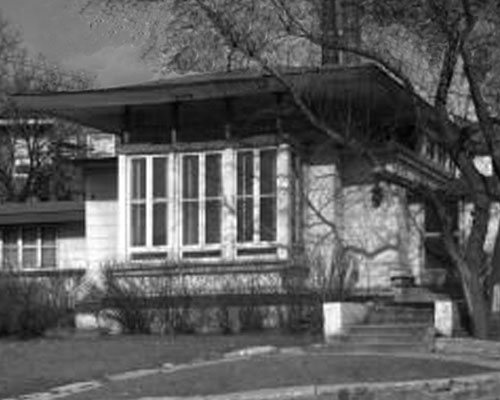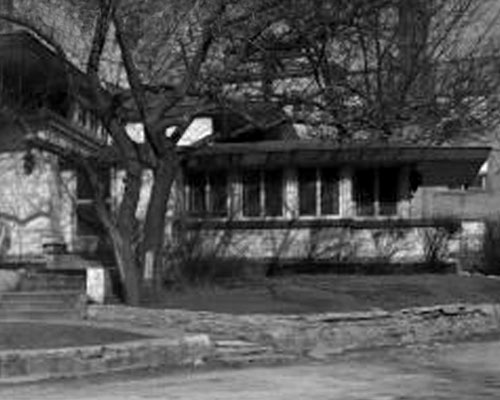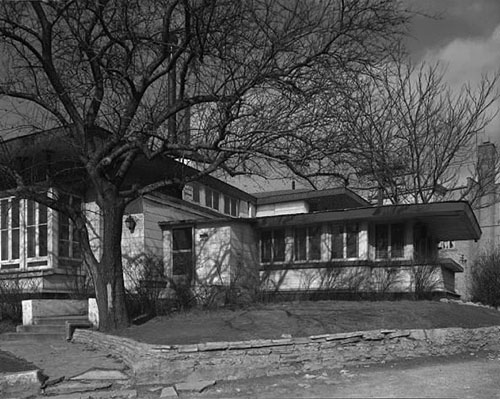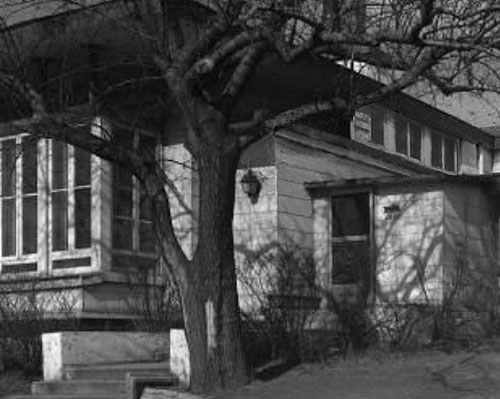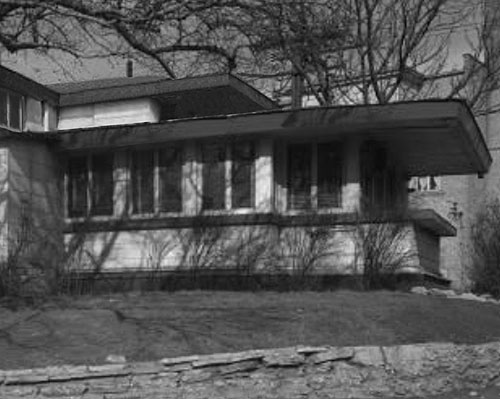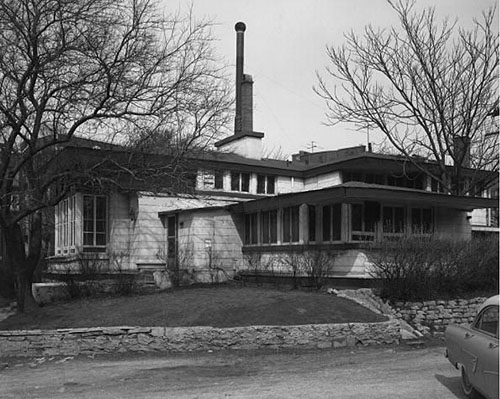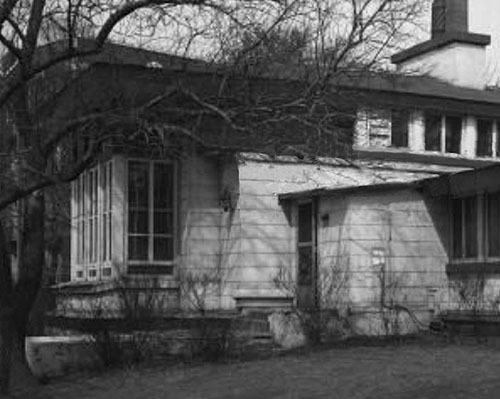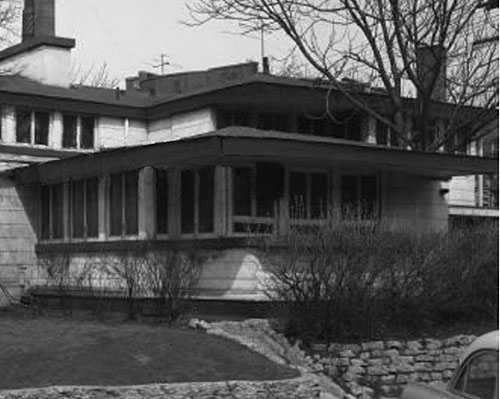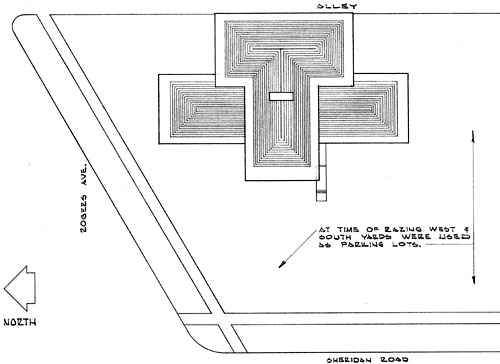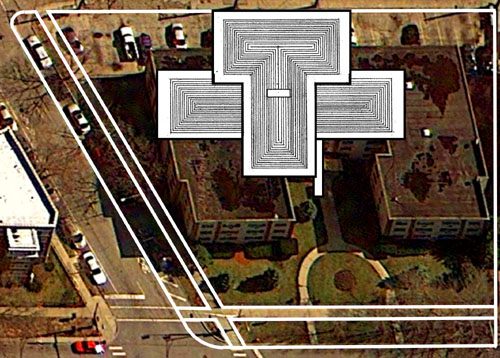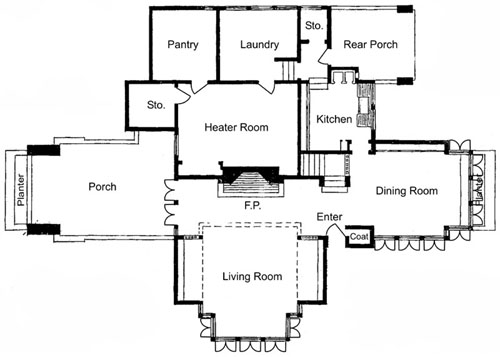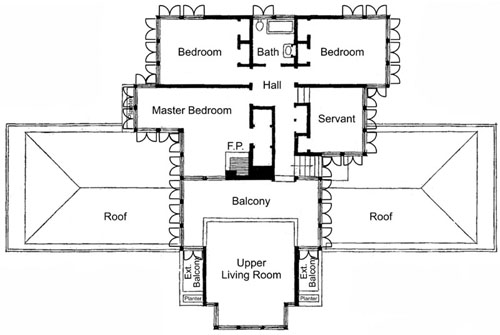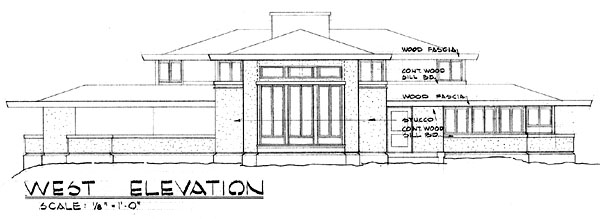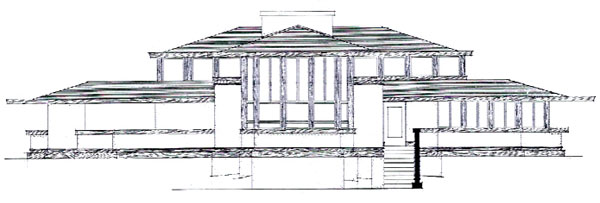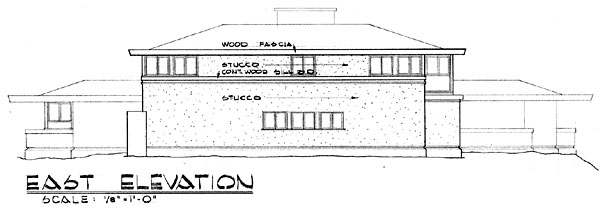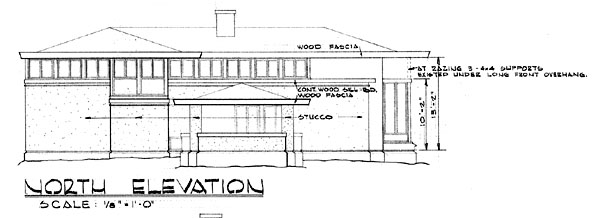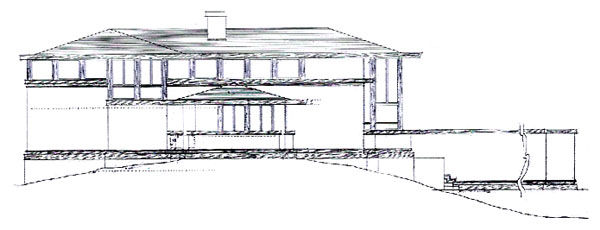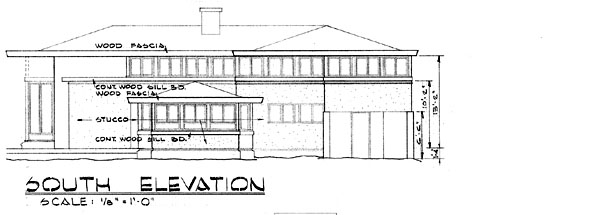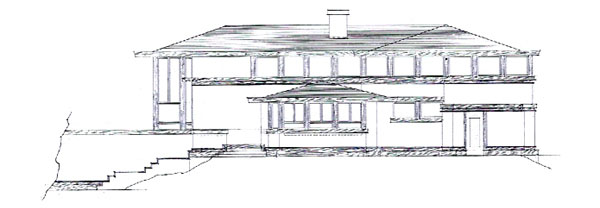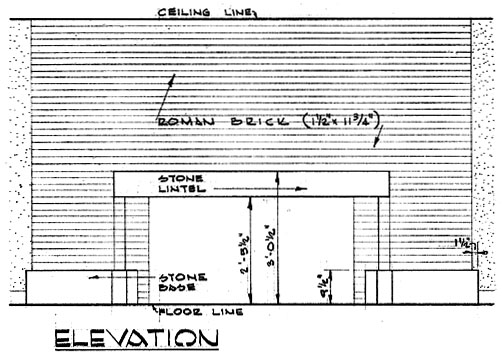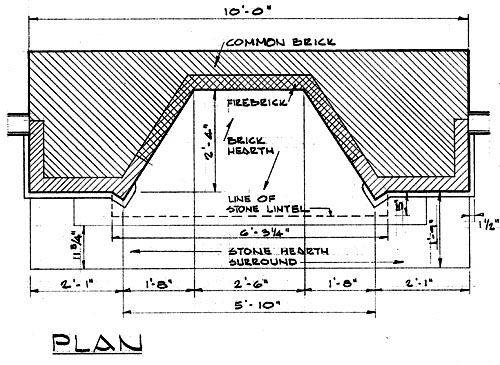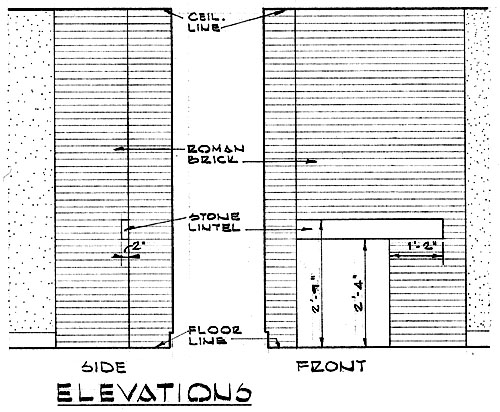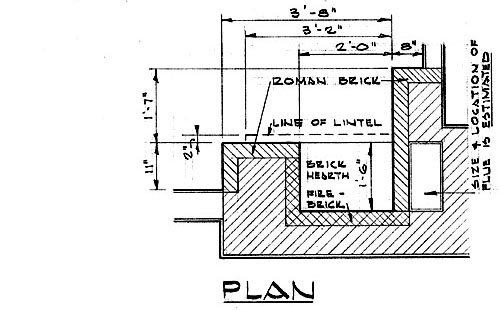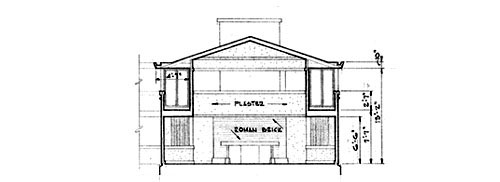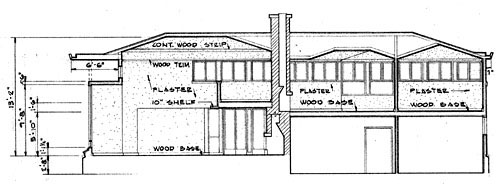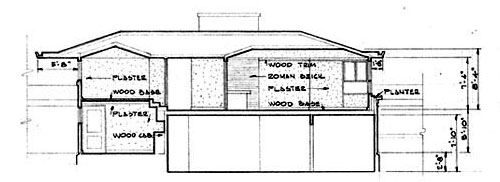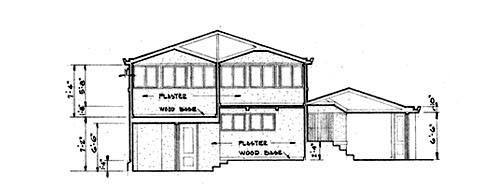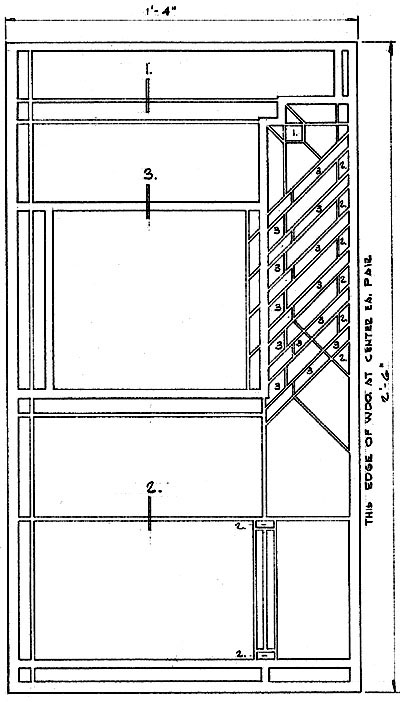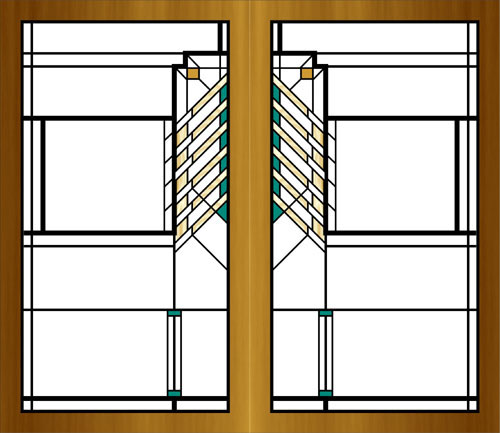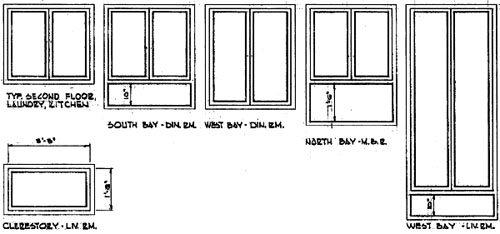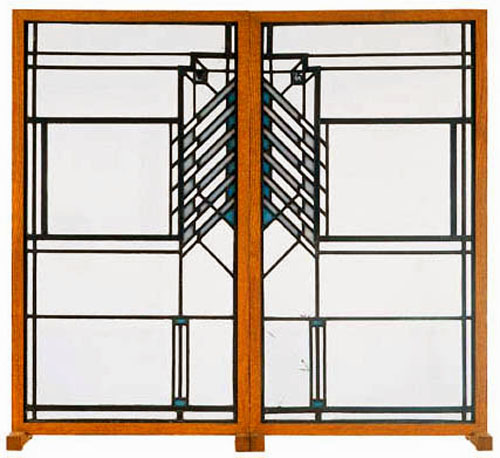
SUPPORT THE
WRIGHT LIBRARY
PROCEEDS FROM EVERY SALE GOES TO SUPPORT THE WRIGHT LIBRARY.
CLICK TO ORDER.
WE PROUDLY SUPPORT THE FRANK LLOYD WRIGHT FOUNDATION

WE PROUDLY SUPPORT THE FRANK LLOYD WRIGHT BUILDING CONSERVANCY
WE PROUDLY SUPPORT FALLINGWATER
AND THE WESTERN PENNSYLVANIA CONSERVANCY

Oscar M. & Katherine B. Steffens Residence, CHICAGO (1909 - S.153) Introduction Floor Plan Original Window 1909 Steffens 1910 Ausgeführte Bauten (1911) Sonderheft (1911) Wendingen 1925
Gilman Lane c1930 Steffens 1936 Steffens 1937 Grant Carpenter Manson c1940 John Gordon Replinger c1950 Hedrich Blessing 1963
HABS 1963 Elevations 1963 Fireplaces 1963 Windows (Sheet 6)Date: 1909
Title: Oscar Steffens Residence, Chicago, Illinois, First Floor Plan, 1909 (1909 - S.153).
Description: Floor plan for the first level of the Steffens Residence. Designed by Frank Lloyd Wright in 1909. The Living Room windows were originally designed to run from floor to ceiling, but alterations created a bay, with the top lining up with the base of the upper clerestory windows. Spindled screens on either side of the Living Room added a measure of privacy. The exterior balcony lowered the ceiling on either side, creating a space with a space. With built-in seating, this feature is reminiscent of the Usonian Living Rooms Wright designed decades later. From the corner of Sheridan and Rogers, the entrance to the home was hidden. Upon entering the home when you turned left (North) and walked past the Living Room and centralized Fireplace, a double set of doors lead out to an enclosed covered porch, with a built-in Planter. The stairs across from the Entrance lead to the second floor. To the right (South) was the Dining Room. A spindled screens enclosed the stairway, adding a sense of privacy. As you pass through the Dining Room, you enter the Kitchen. Passing through the Kitchen allowed access to the utility rooms and the enclosed rear Porch. Stairs lead down to an enclosed Rear Porch, and additional stairs to the Utility rooms which were located behind the Fireplace. By lowering these rooms on the first floor, this allowed the roof line of the bedrooms upstairs to line up with the Living Room roof which was only a story and a half. Courtesy of "Frank Lloyd Wright, Ausgeführte Bauten (Executed Buildings)", 1911. Modified by Douglas M. Steiner. See Additional Information...
Size: 8 x 10 B&W photograph.
S#: 0086.37.1225Date: 1909
Title: Oscar Steffens Residence, Chicago, Illinois, Second Floor Plan, 1909 (1909 - S.153).
Description: Floor plan for the second level of the Steffens Residence. Designed by Frank Lloyd Wright in 1909. As you reach the top of the stairs, turn left and you enter the Balcony which overlooks the Living Room. On either side of the balcony, doors lead out to an exterior Balcony with built-in planters. Bedrooms and the Bath were reached by turning right at the top of the stairs. A row of art glass clerestory windows were recessed just beneath the roof line. Courtesy of "Frank Lloyd Wright, Ausgeführte Bauten (Executed Buildings)", 1911. Modified by Douglas M. Steiner. See Additional Information...
Size: 8 x 10 B&W photograph.
S#: 0086.38.1225Date: 1909
Title: Oscar Steffens Residence, Chicago, Illinois, Clerestory Window 1909 (FLLW #0909) (1909 - S.153).
Description: Original Living Room clerestory window from the Oscar Steffens Residence. One of three clearstory windows in the living room. Designed by Frank Lloyd Wright in 1909. The Steffens Residence is a smaller version of Wright's Prairie styled homes and has been compared in design to the earlier Isabel Roberts Residence (1908 - S.150) in Oak Park.
Wright was most likely contacted just after the purchase of the property or in early 1909. The home was completed by the end of 1909. Many classic Prairie styled features were part of the Steffens' home. Broad overhangs, shallow hipped roof, central fireplace and rows of second story clerestory windows cement stereotypical prairie features. Like the Walter Davidson (1908 - S.149), Isabel Roberts and Frank Baker (1909 - S.151) Residences, the Steffens also included a one and a half story Living Room. But unlike the first three homes where the Living Room windows extended to the roofline, the Steffens Living Room windows stopped short and fell in line with the base of the upper clerestory windows... See Additional Information...
Size: Window frames: 40" wide x 22" high. Leaded glass window: 35" wide x 16" high.
S#: 0086.36.1025
Date: 1909
Title: Oscar Steffens Residence, Chicago, Illinois, West Elevation / Windows, 1909 (1909 - S.153).
Description: Detail of Sheet 4, West Elevation 1963. Lower Level: The covered Porch is on the far left, the Living Room in the center, the entrance just to the right, and the Dining Room is on the far right. Upper Level: The Master Bedroom is on the far left, the upper portion of the Living Room is in the center, with an exterior balcony on either side. A set of doors on either side lead from the interior Balcony to the exterior Balcony. The Bedrooms are on the far right. The Living Room windows were originally designed to run from floor to ceiling (see below), but alterations created a bay, with the top lining up with the base of the upper clerestory windows. Other alterations included reducing the number of windows on the upper level and narrowing the fireplace chimney.
Addition of living room windows. Salvaged windows, saved from destruction and vandalism have survived and maintained by collectors. We inserted examples of the living room and celestory windows. Modified and recreated by Douglas M. Steiner. See Additional Information...
Size: 8 x 10 B&W photograph.
S#: 0086.39.1225Date: Circa 1910 Title: Oscar Steffens Residence (1909 - S.153) Circa 1910.
Description: Viewed from the Northwest, from Rogers Avenue. The covered Porch is on the left, Living Room in the center, and Dining Room on the far right. The entrance is on the right side of the Living Room. The Bedrooms are on the second level, seen above and behind the covered Porch and Living Room. Photographed by Henry Fuermann. Published in "Frank Lloyd Wright, Ausgeführte Bauten", 1911. See Additional Information...
Size: Original 8.5 x 6.5 B&W print
S#: 0094.22.0412
Date: Circa 1910 Title: Oscar Steffens Residence (1909 - S.153) Circa 1910.
Description: Viewed from the West, from the corner of Sheridan Road and Rogers Avenue. The covered Porch is on the left, Living Room in the center, and Dining Room on the far right. The entrance is on the right side of the Living Room. The Bedrooms are on the second level, seen above and behind the covered Porch and Living Room. Most likely photographed by Henry Fuermann at the same time and S#94.22. Published in "Frank Lloyd Wright, Chicago", (Sonderheft) 1911. See Additional Information...
Size: Original 8.1 x 5.75 B&W print
S#: 0094.23.0412
Date: 1910
Title: Book of The North Shore. Homes, Gardens, Landscapes, Highways and Byways, Past and Present (Digital edition) (Published by J. Harrison White, Chicago)
Author: White, Marian A.
Description: "America holds the future." So said Matthew Arnold about the time when Chicago, ravaged by flame, contemplated the ruin of that which had been evolved from the hunting grounds and tepees of the Red Man, and of which she had been justly proud. A momentary pang of anguish, a throb of despair, and the afflicted city, in which the true pioneer enterprise had been a tower of strength from its earliest inception, asserted itself with redoubled might, and over a new trail in its cinereous highways the waters of Lake Michigan, above which still hung a pall of suffocating smoke, caught the resolve"! Will!" while the winds eagerly took up the refrain, and joyously bore the bewitching lay to a sympathizing yet wonder-stricken world. Includes one photograph (Plate 59) of the Oscar M Steffens House (1909 - S.153) by Bemm. See Additional Information...
Size: 6.25 x 10
Pages: Pp 116
S#: 0094.74.0620Date: 1915
Title: Oscar Steffens Residence, Chicago, Illinois, Circa 1915-1920 (1909 - S.153).
Description: Viewed from the West, from the corner of Sheridan Road and Rogers Avenue. The covered Porch is on the left, Living Room in the center, and Dining Room on the far right. The entrance is on the right side of the Living Room. The Bedrooms are on the second level, seen above and behind the covered Porch and Living Room. Judging from the landscape, comparing the trees in the front yard, circa 1915-1920. Published in Wendingen, Volume II No. 4, November, 1925. Also published in The Life-Work of the American Architect Frank Lloyd Wright, Wijdeveld; Wright, 1925-1926. See Additional Information...
Size: Copy 9 x 7 B&W photograph.
S#: 0128.90.1225Date: Circa 1930
Title: Oscar Steffens Residence, Chicago, Illinois, Circa 1930 (1909 - S.153).
Description: Viewed from the Northwest, across the street on Rogers Avenue. Street lamps have been installed. Most of the mature trees are either dead or dying. The North side of the home does not seem to be fairing as well as the South. The stucco finish on the covered Porch is discolored as is the upper balcony wall and soffit. A window, possibly a storm window sets on the upper level terrace by the Northwest corner. Photographed by Gilman Lane. Courtesy of Oak Park Public Library. See Additional Information...
Size: 9 x 6.5 B&W photograph.
S#: 0249.79.1225Date: Circa 1930 Title: Oscar Steffens Residence (1909 - S.153) Circa 1930.
Description: Viewed from the West. Most of the mature trees are either dead or dying. The South side of the home seems to be fairing better than the South. The Living Room is on the left, the entrance in the center, and the Dining Room is on the right. An apartment building on Eastlake Terrace can be seen in the background on the right Photographed by Gilman Lane. Courtesy of Oak Park Public Library. See Additional Information...
Size: Original 8 x 5.75 B&W print
S#: 0249.27.0512
Date: 1936
Title: Oscar Steffens Residence, Chicago, Illinois, Circa 1936 (1909 - S.153).
Description: Viewed from the West, looking toward Lake Michigan which can be seen at the end of the street. The Steffens House can be seen on the right. Designed by Frank Lloyd Wright in 1909. The Steffens would move from their home after just three years. The home was purchased by Otto C. Bach in August 1912. Otto Bach was the brother of another Wright client, Emil Bach (1915 - S.193), located on the same street, a couple miles south.
Otto C. Bach past away on October 7, 1932 at 60 years of age, after living in his Wright designed home for twenty years. His wife Louise moved out of home after her husbands death, but retained ownership. She rented the home, and for the next thirty years the King's Arms Restaurant abused what once was a beautifully designed Frank Lloyd Wright home. When Louise Bach past away, the home went to Otto C. Bach Jr. in December 1960. He continued to rent the property to the restaurant, but when approached by a developer, and with no real ties to the home, sold it to O. W. Howell Enterprises in January 1963. Three months later, and only a skeleton remaining of the home, it was laid to rest.
Photographed on May 13, 1936 by the Illinois Department of Transportation. Courtesy of the IDOT. See Additional Information...
Size: 8 x 10 B&W photograph.
S#: 0404.51.1225Date: 1937
Title: Oscar Steffens Residence, Chicago, Illinois, Circa 1937 (1909 - S.153).
Description: Viewed from the West, looking toward Lake Michigan which can be seen at the end of the street. The Steffens House can be seen on the right. Designed by Frank Lloyd Wright in 1909. The Steffens would move from their home after just three years. The home was purchased by Otto C. Bach in August 1912. Otto Bach was the brother of another Wright client, Emil Bach (1915 - S.193), located on the same street, a couple miles south.
Otto C. Bach past away on October 7, 1932 at 60 years of age, after living in his Wright designed home for twenty years. His wife Louise moved out of home after her husbands death, but retained ownership. She rented the home, and for the next thirty years the King's Arms Restaurant abused what once was a beautifully designed Frank Lloyd Wright home. When Louise Bach past away, the home went to Otto C. Bach Jr. in December 1960. He continued to rent the property to the restaurant, but when approached by a developer, and with no real ties to the home, sold it to O. W. Howell Enterprises in January 1963. Three months later, and only a skeleton remaining of the home, it was laid to rest.
Photographed on December 28, 1937 by the Illinois Department of Transportation. Courtesy of the IDOT. See Additional Information...
Size: 8 x 10 B&W photograph.
S#: 0429.69.1225Date: Circa 1940 Title: Oscar Steffens Residence (1909 - S.153) Circa 1940.
Description: Viewed from the Northwest, across the street on Rogers Avenue. Street lamp is missing it's lens. The exterior stucco has been freshly painted, as has the trim. Storm windows have been added to the covered Porch and Living Room. The front sidewalk that started at Rogers Avenue and passed in front of the Living Room to the Entrance, has been removed and the front yard has been paved. Restaurants must have a sign. but no care was taken to keep any continuity with the design of the home. A smaller sign has been added to the exterior wall to the right of the Living Room bay window. The landing at the top of the stairs has been enclosed. Photographed by Grant Carpenter Manson. Courtesy of Oak Park Public Library. See Additional Information...
Size: Original 8 x 4.6 B&W print
S#: 0531.33.0512
Date: Circa 1950 Title: Oscar Steffens Residence (1909 - S.153) Circa 1950.
Description: Viewed from the Northwest, across the street on Rogers Avenue. The covered Porch is on the left, Living Room in the center and Dining Room on the far right. The front sidewalk that started at Rogers Avenue and passed in front of the Living Room to the Entrance, has been removed and the front yard has been paved. The exterior walls have been covered with asbestos shingles. Storm windows cover the Porch and Living Room windows. An apartment building on Eastlake Terrace can be seen in the background on the far right. Photographed by John Gordon Replinger. Courtesy of the Art Institute of Chicago. See Additional Information...
Size: Original 9 x 7.2 B&W print
S#: 0831.26.0512
Date: 1963 Title: Oscar Steffens Residence (1909 - S.153) 1963.
Description: Photographed just months before its destruction to make room for an apartment complex. The King’s Arms Restaurant, which occupied the facility for the past 30 years, has vacated the premises. Viewed from the Southwest, standing in the parking lot, which used to be the front yard. The covered Porch, now enclosed, is on the left, the Living Room in the center and Dining Room on the far right. The Entrance is to the right of the Living Room. The front yard has been paved. The exterior walls have been covered with asbestos shingles. Storm windows cover the Porch and Living Room windows. Wood beams can be seen above the Living Room Bay which were added to support the large restaurant sign that existed for 30 years. An apartment building on Eastlake Terrace can be seen in the background on the far right. Photographed on January 1, 1963 by Hedrich Blessing. See Additional Information...
Size: Original 6.5 x 5.25 B&W print
S#: 1565.34.0512
Date: 1963 Title: Oscar Steffens Residence (1909 - S.153) 1963.
Description: Photographed just months before its destruction to make room for an apartment complex. The King’s Arms Restaurant, which occupied the facility for the past 30 years, has vacated the premises. Viewed from the Southwest, standing in the parking lot, which used to be the front yard. The Living Room is on the left, The enclosed Entrance was extended thirty years ago when the home was converted to a restaurant. The Dining Room is on the right. The upper level can be seen above the Entrance and Dining Room. The exterior walls have been covered with asbestos shingles. Storm windows cover Living Room and Dining Room windows. Wood beams can be seen above the Living Room Bay which were added to support the large restaurant sign that existed for 30 years. Photographed on January 1, 1963 by Hedrich Blessing. See Additional Information...
Size: Original 9.75 x 8 B&W print.
S#: 1565.35.0512
Date: 1963 Title: Oscar Steffens Residence (1909 - S.153) 1963.
Description: Photographed just months before its destruction to make room for an apartment complex. The King’s Arms Restaurant, which occupied the facility for the past 30 years, has vacated the premises. Viewed from the South, standing in the parking lot, which used to be the side yard. The Living Room is on the left, The enclosed Entrance was extended thirty years ago when the home was converted to a restaurant. The Dining Room is on the right. A storage room, added by the restaurant, is visible just to the right of the third Dining Room window of the south wall. It extends out 4-5 feet and is about eight to nine feet long. The upper level can be seen above the Entrance and Dining Room. The exterior walls have been covered with asbestos shingles. Storm windows cover Living Room and Dining Room windows. Photographed on January 1, 1963 by Hedrich Blessing. See Additional Information...
Size: Original 10 x 8 B&W print
S#: 1565.36.0512
Date: 1963
Title: Oscar Steffens Residence, Chicago, Illinois, Site Plan 1963 (1909 - S.153).
Description: Sheet 1, Site Plan 1963. In April 1963, just before the destruction of the Steffens Residence, architects R. Gardner and J. William Rudd recorded precise measurements for the National Park Service. These drawings, completed on April 4, 1964, along with the written description completed in September 1966, leave an invaluable record of the Oscar Steffens Residence.
Located on the Southeast corner of Sheridan Road and Rogers Avenue, the home was set back against the alley, allowing a larger front and side yard. Being built on the top of a "ridge", the highest point on the lot, also offered expansive views of Lake Michigan from the upper Bedroom windows until apartments blocked the view. The Lake was only half a block away. Courtesy of the National Park Service. See Additional Information...
Size: 10 x 8 B&W photograph.
S#: 1565.93.1225Date: 1963
Title: Oscar Steffens Residence, Chicago, Illinois, Site Plan 1963/2012 (1909 - S.153).
Description: Site Plan (1963) superimposed over an areal view of the lot in 2012. The lot was located on the Southeast corner of Sheridan Road and Rogers Avenue. Set back against the alley, this offered a larger front and side yard. A large apartment complex now occupies the space of the original single family Steffens Residents. Rogers Avenue was widened to accommodate parking on the street. Image courtesy of the Google Maps. See Additional Information...
Size: 10 x 8 Color photograph.
S#: 1565.94.1225Date: 1966 Title: Oscar Steffens House, (HABS No. ILL-1063), 7631 North Sheridan Road, Chicago. (Published by Historic American Building Survey, Office of Archeology and Historic Preservation, National Park Service, Arlington, Virginia.)
Author: Rudd, J. William
Description: Includes "Written Historical and Descriptive Data" (5 sheets), "Measured Drawings" (6 sheets), and Photographs (two photocopies of a photograph and floor plans published in "Frank Lloyd Wright, Ausgeführte Bauten" (Executed Buildings), 1911. In April, 1963, just before the destruction of the Steffens Residence, architects R. Gardner and J. William Rudd recorded precise measurements for the National Park Service. These drawings, completed on April 4, 1964, along with the written description completed in September 1966, leave an invaluable record of the Oscar Steffens Residence. Included are six sheets of measured drawings and a five page report. (First Edition) (Sweeney 2083) See Additional Information...
Size: 8.5 x 11
Pages: Pp 12
S#: 2083.00.0512
Oscar M. & Katherine B. Steffens Residence, CHICAGO (1909 - S.153) Introduction Floor Plan Original Window 1909 Steffens 1910 Ausgeführte Bauten (1911) Sonderheft (1911) Wendingen 1925
Gilman Lane c1930 Steffens 1936 Steffens 1937 Grant Carpenter Manson c1940 John Gordon Replinger c1950 Hedrich Blessing 1963
HABS 1963
Site Plan (Sheet 1) Floor Plan Elevations (Sheet 4) Fireplaces (Sheet 2 & 3) Cross Sections (Sheet 5) Windows (Sheet 6)Introduction
Frank Lloyd Wright chose to include one photograph of the Steffens residence and also the floor plan in "Frank Lloyd Wright, Ausgeführte Bauten" (Executed Buildings), 1911. That same year he published a different photograph in "Frank Lloyd Wright, Chicago" (Sonderheft), 1911. But one year earlier he had not included a drawing of the residence in "Ausgeführte Bauten und Entwürfe von Frank Lloyd Wright".
The Steffens Residence is a smaller version of Wright's Prairie styled homes and has been compared in design to the earlier Isabel Roberts Residence (1908 - S.150) in Oak Park. Although the home was built on a ridge about a block from Lake Michigan in the Birchwood neighborhood, Wright faced the home looking West, away from the lake, leaving few windows on the first floor faced the lake. The bedrooms on the second floor were the only rooms that enjoyed a view of the lake.
Very little information can be found concerning the Steffens or their Frank Lloyd Wright home. According to Cook County records, the property was purchased by Katherine B. Steffens in August 1908. There is no indication why her husband, Oscar M. Steffens was not included on the deed. He was a wealthy business man, and might have left the responsibilities of all aspects of the home in the hands of his capable wife. If she was the one that was responsible for purchasing the property, she may have also been responsible for contacting Wright, or possibly contacting Wright on her husbands behalf.
According to the October 30, 1907 issue of the business journal Clay Record, it was reported that "The Illinois Granite Brick Co. has been incorporated... for the purpose of manufacturing brick. Capital $250,000. Incorporators Oscar M. Steffens, Joseph A. Grober and Arnold D. McMahon." That is the equivalent investment of nearly six million dollars today.
The January 30, 1908 issue of the Clay Record, reported that "The Illinois Granite Brick Co. has purchased 40 acres of sand in Michigan City, Ind. and will build a sand lime brick plant. Paul Fuchs is president, O. M. Steffens treasurer and Leo H. Pleins secretary. All are Chicago men." By April, 1908 train track were installed for hauling brick to Chicago. By September, 1908, construction began for the Illinois Granite Brick Co. brick plant to be built in Michigan City, Ind. Little else can be found concerning the lives of Oscar M. and Katherine B. Steffens.
Wright was most likely contacted just after the purchase of the property or in early 1909. The home was completed by the end of 1909. Many classic Prairie styled features were part of the Steffens' home. Broad overhangs, shallow hipped roof, central fireplace and rows of second story clerestory windows cement stereotypical prairie features. Like the Walter Davidson (1908 - S.149), Isabel Roberts and Frank Baker (1909 - S.151) Residences, the Steffens also included a one and a half story Living Room. But unlike the first three homes where the Living Room windows extended to the roofline, the Steffens Living Room windows stopped short and fell in line with the base of the upper clerestory windows.One questions that begs to be asked. Why was the home not constructed of brick?
There are no records to indicate why the Steffens would move from their home after just three years. The home was purchased by Otto C. Bach in August 1912.
Otto C. Bach was the first of two brothers to own a Wright home. Emil Bach (S.193) hired Wright to design a home in 1915.
Otto Carl Bach was born in Germany on January 18, 1872 to William and Katharina Bach. The Bach family immigrated to Chicago in 1881 when he was nine years old. He attended Bryant & Stratton Business Collage. On January 17, 1907 he married Louise Cora Gatter of Evanston, Illinois, who was born in 1887. She was twenty years old, fifteen years younger than her husband. They had two sons, Otto Carl, Jr., born in June 1909, and Robert W. Bach, born in 1912.
His father, William Bach started one of the first brick manufacturing plants in Chicago, having brought the skill with him from Germany. Carl began working for his father's company, the William Bach & Sons Co. in 1886. He becoming a stockholder in 1900. When his father William Bach, Sr. retired in 1905, Otto and his five brothers changed the name to the Bach Brick Co.
As a result of the many visits to his brother's Wright designed home, Emil Bach had to have one of his own. He purchased a lot just two blocks north of his brother's home on Sheridan Road. In 1915, during the middle of World War I, Wright designed the Emil Bach Residence.
Otto C. Bach past away on October 7, 1932 at 60 years of age, after living in his Wright designed home for twenty years. Birchwood, which had once been a scarcely populated neighborhood was now crowded and bustling. The city of Chicago exploded North with Sheridan Road becoming a major thoroughfare. For reasons unrecorded, Louise moved out of home after her husbands death, but retained ownership. Possibly more than a single mother could manage or afford. She rented the home, and for the next thirty years the King's Arms Restaurant abused was once was a beautifully designed Frank Lloyd Wright home. When Louise Bach past away, the home went to Otto C. Bach Jr. in December 1960. He continued to rent the property to the restaurant, but when approached by a developer, and with no real ties to the home, sold it to O. W. Howell Enterprises in January 1963. Three months later, and only a skeleton remaining of the home, it was laid to rest.
All that survived were a few of the windows. As legend has it, on April 6, 1963, Richard Nickel, the Chicago-born photographer was arrested for "saving" some Frank Lloyd Wright windows from the Oscar Steffens house, which was under demolition. The charges were dropped. According to Thomas Heinz others ended up installed in the Arkansas vacation home of a Chicago architect.
Over a hundred years later, like the Husser residence before it a nondescript apartment complex is located where the Steffens Residence once stood.
April 2012Floor Plan ORIGINAL LIVING ROOM WINDOW 1909
Oscar Steffens Residence, Chicago, Illinois, Clerestory Window 1909 (FLLW #0909) (1909 - S.153). Original Living Room clerestory window from the Oscar Steffens Residence. One of three clearstory windows in the living room. Designed by Frank Lloyd Wright in 1909. The Steffens Residence is a smaller version of Wright's Prairie styled homes and has been compared in design to the earlier Isabel Roberts Residence (1908 - S.150) in Oak Park.
Wright was most likely contacted just after the purchase of the property or in early 1909. The home was completed by the end of 1909. Many classic Prairie styled features were part of the Steffens' home. Broad overhangs, shallow hipped roof, central fireplace and rows of second story clerestory windows cement stereotypical prairie features. Like the Walter Davidson (1908 - S.149), Isabel Roberts and Frank Baker (1909 - S.151) Residences, the Steffens also included a one and a half story Living Room. But unlike the first three homes where the Living Room windows extended to the roofline, the Steffens Living Room windows stopped short and fell in line with the base of the upper clerestory windows.
On the West end of the living room were three sets of tall vertical windows. On the North and South sides of the west end were an additional set of tall vertical windows. Instead of the west wall of the livingroom running floor to ceiling, Wright dropped the ceiling three feet, brought each side in six feet, forming an enclosed “alcove”. Directly above the alcove, in-line with tyhe three sets of tall vertical windows were these three clerestory windows.
It is interesting to note that in 1909, Sheridan Road was a developing thoroughfare. Much busier than a residencial street. Wright envisioned the area in the future. Although the home was built on a ridge about a block from Lake Michigan in the Birchwood neighborhood, Wright faced the home looking West, away from the lake, leaving only three windows on the first floor faced the lake.
“Richard Nickel was arrested on April 6, 1963, for removingleaded-glass windows from the Oscar Steffens residence, anabandoned Frank Lloyd Wright home on Sheridan in the process of being demolished. Aaron tipped him off that the home was scheduled to be razed. The first-floor windows had been shattered by kids, and only ten of twelve remained on the second floor when Nickel decided to try and save them. The police saw him moving them from the house to the sidewalk. He tried to explain to them their significance. Frank Lloyd who, they asked. The charges were finally dropped.” Keeper of the Rise, Nathan Prince, 2017. Many of the windows Nickel saved remained intact.
Thomas Heinz wrote, “The use of blue glass was very unusual in the Prairie years but signaled what was to come in the Barnsdall (1705) and Ennis (240l) Houses. The patterns in this house frequently extended through several windows. The design seems to be a development of what was started in the same year at the Mrs Gale Thomas House (0905).” Frank Lloyd Wright Art Glass, Heinz, 1994, p.143.
Julie Sloan wrote: “The Steffens windows were designed to be seen in pairs, which reestablished symmetry in their composition... The Steffens windows belong to the same design family as the Mrs. Gale windows, but since they were designed as paired casements, they are not as daring in their asymmetry. They take the half-feather formula one step further in complexity of design, using more lines and additional color—pale blue, an unusual hue in a Wright window. It has been suggested that this color was chosen to blend with the view of Lake Michigan. The skylight pattern echoes that of the casements. Interestingly, an earlier sketch for the windows (fig. 352) shows a checkerboard pattern very similar to that used in the Eugene A. Gilmore windows (1908); it is not known why this was abandon.” Light Screens, Sloan, 2001.
Executed in clear and gold-foiled glass. Copper-plated zinc cames are in two widths. 1/4" and 3/8" wide. Composed of 30 pieces of glass. Window frames: 40" wide x 22" high. Leaded glass window: 35" wide x 16" high. Acquired from a private collection through Toomey & Company. (S#0086.36.1025)
1) Oscar Steffens Residence, Chicago, Illinois, Clerestory Window 1909 (FLLW #0909) (1909 - S.153). Original Living Room clerestory window from the Oscar Steffens Residence. One of three clearstory windows in the living room. Designed by Frank Lloyd Wright in 1909. The Steffens Residence is a smaller version of Wright's Prairie styled homes and has been compared in design to the earlier Isabel Roberts Residence in Oak Park.
Executed in clear and gold-foiled glass. Copper-plated zinc cames are in two widths. 1/4" and 3/8" wide. Window frames: 40" wide x 22" high. Leaded glass window: 35" wide x 16" high. (S#0086.36.1025)2) Detail of the Oscar Steffens Residence, Chicago, Illinois, Clerestory Window 1909 (FLLW #0909) (1909 - S.153). Original Living Room clerestory window from the Oscar Steffens Residence. One of three clearstory windows in the living room. Executed in clear and gold-foiled glass. Copper-plated zinc cames are in two widths. 1/4" and 3/8" wide. Window frames: 40" wide x 22" high. Leaded glass window: 35" wide x 16" high. (S#0086.36.1025) 3) Detail of the Oscar Steffens Residence, Chicago, Illinois, Clerestory Window 1909 (FLLW #0909) (1909 - S.153). Original Living Room clerestory window from the Oscar Steffens Residence. One of three clearstory windows in the living room. Executed in clear and gold-foiled glass. Copper-plated zinc cames are in two widths. 1/4" and 3/8" wide. Window frames: 40" wide x 22" high. Leaded glass window: 35" wide x 16" high. (S#0086.36.1025) 4) Detail of the Oscar Steffens Residence, Chicago, Illinois, Clerestory Window 1909 (FLLW #0909) (1909 - S.153). Original Living Room clerestory window from the Oscar Steffens Residence. One of three clearstory windows in the living room. Executed in clear and gold-foiled glass. Copper-plated zinc cames are in two widths. 1/4" and 3/8" wide. Window frames: 40" wide x 22" high. Leaded glass window: 35" wide x 16" high. (S#0086.36.1025) 5) Detail of the Oscar Steffens Residence, Chicago, Illinois, Clerestory Window 1909 (FLLW #0909) (1909 - S.153). Original Living Room clerestory window from the Oscar Steffens Residence. One of three clearstory windows in the living room. Executed in clear and gold-foiled glass. Copper-plated zinc cames are in two widths. 1/4" and 3/8" wide. Window frames: 40" wide x 22" high. Leaded glass window: 35" wide x 16" high. (S#0086.36.1025) WEST ELEVATION / WINDOWS 1909 1) Oscar Steffens Residence, Chicago, Illinois, West Elevation / Windows, 1909 (1909 - S.153).
Detail of Sheet 4, West Elevation 1963. Lower Level: The covered Porch is on the far left, the Living Room in the center, the entrance just to the right, and the Dining Room is on the far right. Upper Level: The Master Bedroom is on the far left, the upper portion of the Living Room is in the center, with an exterior balcony on either side. A set of doors on either side lead from the interior Balcony to the exterior Balcony. The Bedrooms are on the far right. The Living Room windows were originally designed to run from floor to ceiling (see below), but alterations created a bay, with the top lining up with the base of the upper clerestory windows. Other alterations included reducing the number of windows on the upper level and narrowing the fireplace chimney.
Addition of living room windows. Salvaged windows, saved from destruction and vandalism have survived and maintained by collectors. We inserted examples of the living room and celestory windows. Modified and recreated by Douglas M. Steiner. (S#0086.39.1225)2) Detail of the Oscar Steffens Residence West Elevation / Windows, 1909 (1909 - S.153). Addition of living room windows. Salvaged windows, saved from destruction and vandalism have survived and maintained by collectors. We inserted examples of the living room and celestory windows. 3) Detail of the Oscar Steffens Residence West Elevation / Windows, 1909 (1909 - S.153). Addition of living room windows. Salvaged windows, saved from destruction and vandalism have survived and maintained by collectors. We inserted examples of the living room and celestory windows. 4) Detail of the Oscar Steffens Residence West Elevation / Windows, 1909 (1909 - S.153). Addition of living room windows. Salvaged windows, saved from destruction and vandalism have survived and maintained by collectors. We inserted examples of the living room and celestory windows. OSCAR STEFFENS RESIDENCE 1910
Published in Book of The North Shore. Includes one photograph (Plate 59) of the Oscar M Steffens House (1909 - S.153) by Bemm. (S#0094.74.0620) Frank Lloyd Wright, Ausgefuhrte Bauten 1911
One year after Frank Lloyd Wright produced the "Ausgeführte Bauten und Entwürfe von Frank Lloyd Wright" (S.87), he wrote and produced "Frank Lloyd Wright, Ausgeführte Bauten" (Executed Buildings). All in German, it was published by Ernst Wasmuth A.-G., Berlin in 1911. Wright included one photograph (page 60) and the floor plan for the first and second floors. But the floor plans were miss labeled. The floor plans (page 61) labeled for the Steffens residence were actually those for the Evans residence (1908 - S.140) and vice versa. The Steffens floor plans are on page 85.
1) Viewed from the Northwest, from Rogers Avenue. The covered Porch is on the left, Living Room in the center, and Dining Room on the far right. The entrance is on the right side of the Living Room. The Bedrooms are on the second level, seen above and behind the covered Porch and Living Room. Photographed by Henry Fuermann, circa 1910. (S#0094.22.0412) 2) View of the covered Porch. Originally designed without windows, the porch was open on three sides. It is not clear if this alteration was completed during the initial construction period, much like the alteration to the Living Room windows, but it is clear that by this time (circa 1910) the windows now enclosed the covered porch. They were plain glass windows, not leaded glass like all the other windows in the home. A signature of Wright's prairie design, the low broad roof cantilevered over a built-in planter on the far left. Photographed in the late fall or early spring, the planter appears unused. Construction was of a cream colored stucco (HABS) and dark wood trim. It appears that Lake Michigan can be glimpsed through the trees to the left of the porch. 3) The Bedrooms were on the second level, seen above and behind the covered Porch and Living Room. The utility rooms and the rear Porch on the first level were lowered on the first floor, allowing the roofline of the bedrooms upstairs to line up with the Living Room roof. The Living Room was only a story and a half. Construction was of a cream colored stucco and dark wood trim. A row of art glass clerestory windows were recessed just beneath the roof line on the second floor. 4) The living room rose one and a half floors. A row of art glass clerestory windows were recessed just beneath the roof line on the second floor. On either side of the balcony on the second floor, doors lead out to an exterior Balcony with built-in Planters, which appear to be unused. Construction was of a cream colored stucco and dark wood trim. The massive stereotypical Prairie style chimney serviced two Fireplaces and the heating system. 5) The living room rose one and a half floors. But unlike the Davidson, Isabel Roberts and Baker homes, where the windows extended from the floor to the ceiling, the Steffens Living Room art glass windows stopped short and fell in line with the base of the upper clerestory windows creating a bay. A row of art glass clerestory windows were recessed beneath the roof line. A built-in Planter extended out in front of the bay windows, but appears to be unused. From Rogers Avenue, an entrance sidewalk passed in front of the Living Room, and stairs lead to the Entrance which was to the right of the Living Room. Construction was of a cream colored stucco and dark wood trim. 6) From Rogers Avenue, an entrance sidewalk passed in front of the Living Room, and stairs lead to the Entrance which was to the right of the Living Room. A pedestal appears on the right at the top of the stairs, but there was no evidence that one of Wright's signature concrete vases were ever placed there. The Dining Room can be seen in the background. 7) Floor plan for the First level (page 85). The Living Room windows were originally designed to run from floor to ceiling, but alterations created a bay, with the top lining up with the base of the upper clerestory windows. Spindled screens on either side of the Living Room added a measure of privacy. The exterior balcony lowered the ceiling on either side, creating a space with a space. With built-in seating, this feature is reminiscent of the Usonian Living Rooms Wright designed decades later. From the corner of Sheridan and Rogers, the entrance to the home was hidden. Upon entering the home when you turned left (North) and walked past the Living Room and centralized Fireplace, a double set of doors lead out to an enclosed covered porch, with a built-in Planter. The stairs across from the Entrance lead to the second floor. To the right (South) was the Dining Room. A spindled screens enclosed the stairway, adding a sense of privacy. As you pass through the Dining Room, you enter the Kitchen. Passing through the Kitchen allowed access to the utility rooms and the enclosed rear Porch. Stairs lead down to the Rear Porch, and additional stairs to the Utility rooms which were located behind the Fireplace. By lowering these rooms on the first floor, this allowed the roofline of the bedrooms upstairs to line up with the Living Room roof which was only a story and a half. 8) Floor plan for the Second level (page 85). As you reach the top of the stairs, turn left and you enter the Balcony which overlooks the Living Room. On either side of the balcony, doors lead out to an exterior Balcony with built-in Planters. Bedrooms and the Bath were reached by turning right at the top of the stairs. A row of art glass clerestory windows were recessed just beneath the roof line. Frank Lloyd Wright, Chicago (Sonderheft), 1911
One year after Frank Lloyd Wright produced the "Ausgeführte Bauten und Entwürfe von Frank Lloyd Wright" (S.87), he wrote and produced "Frank Lloyd Wright, Ausgeführte Bauten" (Executed Buildings). All in German, it was published by Ernst Wasmuth A.-G., Berlin in 1911. That same year he published a different photograph in "Frank Lloyd Wright, Chicago" Verlegt bei Ernst Wasmuth A.-G., Berlin 1911. (8. Sonderheft der Architektur des XX. Jahrhunderts. #8 Special Edition of Architecture of the 20th Century.) It was also published by Ernst Wasmuth A.-G., Berlin. It was a second Version of "Frank Lloyd Wright Ausgefuhrte Bauten" (Ececited Buildings). The text is the same, but laid out differently. Some of the photos and Illustrations also differ. The cover states that "This German issue is for sale only in Europe." Wright included one photograph on page 51.
1) Viewed from the West, from the corner of Sheridan Road and Rogers Avenue. The covered Porch is on the left, Living Room in the center, and Dining Room on the far right. The entrance is on the right side of the Living Room. The Bedrooms are on the second level, seen above and behind the covered Porch and Living Room. Most likely photographed by Henry Fuermann, circa 1910. (S#0094.23.0412) 2) View of the covered Porch. Originally designed without windows, the porch was open on three sides. It is not clear if this alteration was completed during the initial construction period, much like the alteration to the Living Room windows, but it is clear that by this time (circa 1910) the windows now enclosed the covered porch. They were plain glass windows, not leaded glass like all the other windows in the home. A signature of Wright's prairie design, the low broad roof cantilevered over a built-in planter on the far left. Photographed in the late fall or early spring, the planter appears unused. Construction was of a cream colored stucco (HABS) and dark wood trim. 3) The Bedrooms were on the second level, seen above and behind the covered Porch. The utility rooms and the rear Porch on the first level were lowered on the first floor, allowing the roofline of the bedrooms upstairs to line up with the Living Room roof. The Living Room was only a story and a half. Construction was of a cream colored stucco and dark wood trim. A row of art glass clerestory windows were recessed just beneath the roof line on the second floor. 4) The living room rose one and a half floors. But unlike the Davidson, Isabel Roberts and Baker homes, where the windows extended from the floor to the ceiling, the Steffens Living Room art glass windows stopped short and fell in line with the base of the upper clerestory windows creating a bay. A row of art glass clerestory windows were recessed beneath the roof line. A built-in Planter extended out in front of the bay windows, but appears to be unused. A signature of Wright's prairie design, the low broad roof cantilevered over the window bay. From Rogers Avenue, an entrance sidewalk passed in front of the Living Room, and stairs lead to the Entrance which was to the right of the Living Room. Construction was of a cream colored stucco and dark wood trim. 5) The living room rose one and a half floors. But the Living Room art glass windows stopped short and fell in line with the base of the upper clerestory windows creating a bay. Three sets of windows each measured 40" wide by 81" high. A row of art glass clerestory windows were recessed beneath the roof line. A built-in Planter extended out in front of the bay windows, but appears to be unused. 6) From Rogers Avenue, an entrance sidewalk passed in front of the Living Room, and stairs lead to the Entrance which was to the right of the Living Room. A pedestal appears on the right at the top of the stairs, but there was no evidence that one of Wright's signature concrete vases were ever placed there. The Dining Room can be seen in the background. The art glass pattern can be seen in the Dining Room windows. 7) One of the many light fixtures Wright specified on the interior can be seen on the far left. A pedestal appears on the right at the top of the stairs, but there was no evidence that one of Wright's signature concrete vases were ever placed there. The Dining Room can be seen in the background. The art glass pattern can be seen in the Dining Room windows. 8) One of the many light fixtures Wright specified on the interior can be seen on the far left. The art glass pattern can be seen in the Dining Room windows. Wendingen Volume VII, Number 4, 1925
Wendingen, a Dutch art magazine, was published monthly between 1918 and 1931. Many of the 116 issues were edited and designed by Hendrik Theodorus Wijdeveld, a Dutch architect and designer. It was published for architects and interior designers by Amsterdam publisher Hooge Brug and was a mouthpiece for the architect association "Architectura et Amicitia", an Amsterdam-based society, which developed into the major representative of the Amsterdam School. H. Th. Wijdeveld was the chief editor.
Eight issues were devoted to Frank Lloyd Wright's work. The first was Volume IV, Number 11, 1921. The cover, designed by El Lissitzky, is considered to be one of his greatest compositions.
In 1925, a series of seven issues were published on thework of Wright, Volume VII, Numbers 3 - 9.
That year all seven issues were combined into a bound volume entitled "The Life Work of the American Architect: Frank Lloyd Wright", 1925, published by C.A. Mees Santpoort, Holland. In 1947 A. Kroch ordered 500 copies of the remaining unbound stock and published the volume in 1948.
In 1965, Horizon Press republished a boxed version entitled "The Work of Frank Lloyd Wright, The Great Wendingen Edition"
For more information on the Wendingen publications see "Wendingen, A Journal for the Arts 1918 - 1932".
Wright included one photograph of the Steffens home in Volume VII, Numbers 4, page 52.Gilman Lane Circa 1930
Gilman Lane photographed building in the Chicago area including many of Wright’s work. Upon his death in 1961, Lane donated his collection of over 700 photographs to the Oak Park Public Library. According to William Jerousek, Librarian at the OPPL, Lane was an industrial arts teacher at the Oak Park-River Forest High School from 1923 to 1957.
Whether a one-time professional, part time freelance, or "amateur", the results were anything but amateur. He left an early record of over 150 Wright buildings. In the seminal Biography of Wright's Work by Henry-Russell Hitchcock, "The Nature of Materials", Hitchcock credits Henry Fuermann and Sons, and "another important group of photographs taken by Gilman Lane...who has been photographing Wright's work for many years, and who has taken many new photographs particularly for this book."
Lane began documenting Wright's work in the 1920s. There are two Lane photographs of the Steffens residence in the OPPL collection. Although a flare damages the first, it gives us a glimpse into the condition of the home. Street lamps have been installed. Most of the mature trees are either dead or dying. The North side of the home does not seem to be fairing as well as the South. The stucco finish on the covered Porch is discolored as is the upper balcony wall and soffit.
The home wasn't converted to a restaurant until 1933, so these two photographs were taken before then.
1) Viewed from the Northwest, across the street on Rogers Avenue. Street lamps have been installed. Most of the mature trees are either dead or dying. The North side of the home does not seem to be fairing as well as the South. The stucco finish on the covered Porch is discolored as is the upper balcony wall and soffit. Photographed by Gilman Lane. Courtesy of Oak Park Public Library. (S#0249.79.1225) 1A) Street lamps have been installed. The stucco finish on the covered Porch is discolored as is the upper balcony wall and soffit. 1B) The stucco finish of the upper balcony wall and soffit is badly discolored. 2) Viewed from the West. Most of the mature trees are either dead or dying. The South side of the home seems to be fairing better than the South. The Living Room is on the left, the entrance in the center, and the Dining Room is on the right. An apartment building on Eastlake Terrace can be seen in the background on the right Photographed by Gilman Lane. Courtesy of Oak Park Public Library. (S#0249.27.0512) 2A) The art glass pattern is visible in the Living Room windows. Only the side windows open, as do the clerestory windows above. 2B) From Rogers Avenue, an entrance sidewalk passed in front of the Living Room, and stairs lead to the Entrance which is to the right of the Living Room. 2C) Detail of the Dining Room.. STEFFENS RESIDENCE 1936
1) Oscar Steffens Residence, Chicago, Illinois, Circa 1936 (1909 - S.153). Viewed from the West, looking toward Lake Michigan which can be seen at the end of the street. The Steffens House can be seen on the right. Designed by Frank Lloyd Wright in 1909. The Steffens would move from their home after just three years. The home was purchased by Otto C. Bach in August 1912. Otto Bach was the brother of another Wright client, Emil Bach (1915 - S.193), located on the same street, a couple miles south. Photographed on May 13, 1936 by the Illinois Department of Transportation. Courtesy of the IDOT. (S#0404.51.1225) 2) Detail of the Oscar Steffens Residence, Chicago, Illinois, Circa 1936 (1909 - S.153). Viewed from the West, looking toward Lake Michigan which can be seen at the end of the street. STEFFENS RESIDENCE 1937
1) Oscar Steffens Residence, Chicago, Illinois, Circa 1937 (1909 - S.153). Viewed from the West, looking toward Lake Michigan which can be seen at the end of the street. The Steffens House can be seen on the right. Designed by Frank Lloyd Wright in 1909. The Steffens would move from their home after just three years. The home was purchased by Otto C. Bach in August 1912. Otto Bach was the brother of another Wright client, Emil Bach (1915 - S.193), located on the same street, a couple miles south. Photographed on December 28, 1937 by the Illinois Department of Transportation. Courtesy of the IDOT. (S#0429.69.1225) 2) Detail of the Oscar Steffens Residence, Chicago, Illinois, Circa 1937 (1909 - S.153). Viewed from the West, looking toward Lake Michigan which can be seen at the end of the street. Grant Carpenter Manson, Circa 1940
Architectural historian Grant Carpenter Manson first met Mr. Wright in 1938. He had decided to make Wright the subject of his doctoral dissertation while at Harvard. He felt it essential to meet Wright and so in September he headed toward Spring Green from Massachusetts. Upon reaching Chicago, he placed a call to Spring Green and asked the operator “to put him through to Mr. Wright”. He heard his voice for the first time. Manson took photographs between 1937 and 1941 while researching for his doctoral dissertation titled “Frank Lloyd Wright's Work Before 1910". While a professor at the University of Pennsylvania, he elaborated his thesis and published his book “Frank Lloyd Wright to 1910: The First Golden Age" in 1958. Upon publication, Manson hand delivered a copy of the book to Wright in New York.
Mr. Manson gave the photographs and other materials to the library in July 1973. Grant Carpenter Manson (1904-1997).
Upon Otto C. Bach's death in 1932, Louise moved out after living in their Wright home for twenty years. She retained ownership of the home, and due to the expansion of the city, everincreasing apartment complexes in the neighborhood and its location on Sheridan Road, it became home to the King's Arms Restaurant for the next thirty years.
Most likely photographed around 1940 on a warm Winter or Spring day. Snow is melting and and clientele for the local apartment complexes are plentiful. Sandy Goldman, reminiscing about the Rogers Park Community wrote, the "...King’s Arms restaurant (great food; great bar) stood on a hill at the S.E corner..."
The exterior stucco has been freshly painted, as has the trim. Storm windows have been added to the covered Porch and Living Room. The front sidewalk that started at Rogers Avenue and passed in front of the Living Room to the Entrance, has been removed and the front yard has been paved. Restaurants must have a sign. but no care was taken to keep any continuity with the design of the home. A smaller sign has been added to the exterior wall to the right of the Living Room bay window. The landing at the top of the stairs has been enclosed.
1) Viewed from the Northwest, across the street on Rogers Avenue. Street lamp is missing it's lens. The exterior stucco has been freshly painted, as has the trim. Storm windows have been added to the covered Porch and Living Room. The front sidewalk that started at Rogers Avenue and passed in front of the Living Room to the Entrance, has been removed and the front yard has been paved. Restaurants must have a sign. but no care was taken to keep any continuity with the design of the home. A smaller sign has been added to the exterior wall to the right of the Living Room bay window. The landing at the top of the stairs has been enclosed. Photographed by Grant Carpenter Manson. Courtesy of Oak Park Public Library. (S#0531.33.0512) 2) The exterior stucco has been freshly painted, as has the trim. Storm windows have been added to the covered Porch. 3) The exterior stucco has been freshly painted, as has the trim. Storm windows have been added to the Living Room. Restaurants must have a sign. but no care was taken to keep any continuity with the design of the home. A smaller sign has been added to the exterior wall to the right of the Living Room bay window. The landing at the top of the stairs has been enclosed. 4) A smaller sign has been added to the exterior wall to the right of the Living Room bay window. The landing at the top of the stairs has been enclosed. John Gordon Replinger, Circa 1950
John Gordon Replinger was born in 1921. became a professor in 1951 at the University of Illinois, School of Architecture. He received a BS in architecture and an MS from the University. Prof. Replinger attained tenure in 1961 and retired in 1985. He designed over forty houses, mainly in Champaign-Urbana, Michigan, California, and Florida. Additionally, he designed 80 residential additions. He passed away March 27, 2006.
In 1951, John Replinger, published "An Introduction to theArchitecture of the Prairie School: Maher, Wright, Griffin", published by the University of Illinois, Urbana, Ill. For this volume he photographed the Oscar Steffens residence.
Viewed from the Northwest, across the street on Rogers Avenue. The exterior walls have been covered with asbestos shingles. An unsightly smoke stack has been added above the chimney.
1) Viewed from the Northwest, across the street on Rogers Avenue. The covered Porch is on the left, Living Room in the center and Dining Room on the far right. The front sidewalk that started at Rogers Avenue and passed in front of the Living Room to the Entrance, has been removed and the front yard has been paved. The exterior walls have been covered with asbestos shingles. Storm windows cover the Porch and Living Room windows. An apartment building on Eastlake Terrace can be seen in the background on the far right. Photographed by John Gordon Replinger. Courtesy of the Art Institute of Chicago. (S#0831.26.0512) 2) The exterior walls have been covered with asbestos shingles. Storm windows cover the Porch windows. 3) The exterior walls have been covered with asbestos shingles. Storm windows cover the Living Room windows. An apartment building on Eastlake Terrace can be seen in the background on the right. 4) The Entrance is to he right of the Living Room Bay. The Dining Room can be seen in the center. An apartment building on Eastlake Terrace can be seen in the background on the far right. Hedrich Blessing, January 1, 1963
Ken Hedrich and Henry Blessing founded Hedrich Blessing in 1929. When Blessing left for Denver within the year, brother Ed Hedrich came in to manage the office. In 1931 brother Bill came on board as the first of hundreds of photographic assistants who would learn their craft at HB.
In 1937 Architectural Forum magazine commissioned Hedrich Blessing to photograph recent works of Frank Lloyd Wright. Kenmade several trips to Taliesin and formed another lifelong collaboration with Wright. Bill’s images of the Kaufman residence in Pennsylvania so captured the essence of Wright’s masterpiece that it reputedly inspired the name “Falling Water”.
These photographs were taken on January 1, 1963, just months before its destruction of the Oscar Steffens residence, to make room for an apartment complex.
1) Photographed just months before its destruction to make room for an apartment complex. The King’s Arms Restaurant, which occupied the facility for the past 30 years, has vacated the premises. Viewed from the Southwest, standing in the parking lot, which used to be the front yard. The covered Porch, now enclosed, is on the left, the Living Room in the center and Dining Room on the far right. The Entrance is to the right of the Living Room. The front yard has been paved. The exterior walls have been covered with asbestos shingles. Storm windows cover the Porch and Living Room windows. Wood beams can be seen above the Living Room Bay which were added to support the large restaurant sign that existed for 30 years. An apartment building on Eastlake Terrace can be seen in the background on the far right. Photographed on January 1, 1963 by Hedrich Blessing. (S#1565.34.0512) 1A) The covered Porch, now enclosed, is on the far left, the Living Room in the center. The Entrance is to the right of the Living Room. The front yard has been paved. The exterior walls have been covered with asbestos shingles. Storm windows cover the Porch and Living Room windows. Wood beams can be seen above the Living Room Bay which were added to support the large restaurant sign that existed for 30 years. 1B) The Living Room is on the far left, the Dining Room on the far right. The Entrance is to the right of the Living Room. The front yard has been paved. The exterior walls have been covered with asbestos shingles. 2) Photographed just months before its destruction to make room for an apartment complex. The King’s Arms Restaurant, which occupied the facility for the past 30 years, has vacated the premises. Viewed from the Southwest, standing in the parking lot, which used to be the front yard. The Living Room is on the left, The enclosed Entrance was extended thirty years ago when the home was converted to a restaurant. The Dining Room is on the right. The upper level can be seen above the Entrance and Dining Room. The exterior walls have been covered with asbestos shingles. Storm windows cover Living Room and Dining Room windows. Wood beams can be seen above the Living Room Bay which were added to support the large restaurant sign that existed for 30 years. Photographed on January 1, 1963 by Hedrich Blessing. (S#1565.35.0512) 2A) The Living Room is on the left, The enclosed Entrance was extended thirty years ago when the home was converted to a restaurant. The upper level can be seen above the Entrance. The exterior walls have been covered with asbestos shingles. Storm windows cover Living Room. Wood beams can be seen above the Living Room Bay which were added to support the large restaurant sign that existed for 30 years. 2B) The Entrance is to the left of the Dining Room. Built-in exterior planters extend below the windows on the right. The upper level can be seen above the Entrance and Dining Room. The exterior walls have been covered with asbestos shingles. Storm windows cover Dining Room windows. 3) Photographed just months before its destruction to make room for an apartment complex. The King’s Arms Restaurant, which occupied the facility for the past 30 years, has vacated the premises. Viewed from the South, standing in the parking lot, which used to be the side yard. The Living Room is on the left, The enclosed Entrance was extended thirty years ago when the home was converted to a restaurant. The Dining Room is on the right. A storage room, added by the restaurant, is visible just to the right of the third Dining Room window of the south wall. It extends out 4-5 feet and is about eight to nine feet long. The upper level can be seen above the Entrance and Dining Room. The exterior walls have been covered with asbestos shingles. Storm windows cover Living Room and Dining Room windows. Photographed on January 1, 1963 by Hedrich Blessing. (S#1565.36.0512) 3A) Viewed from the South, standing in the parking lot, which used to be the side yard. The Living Room is on the left, The enclosed Entrance was extended thirty years ago when the home was converted to a restaurant. The Dining Room is on the right. The upper level can be seen above the Entrance and Dining Room. The exterior walls have been covered with asbestos shingles. Storm windows cover Living Room and Dining Room windows. 3B) The enclosed Entrance is on the far left. The Dining Room is in the center. A storage room, added by the restaurant, is visible just to the right of the third Dining Room window of the south wall. It extends out 4-5 feet and is about eight to nine feet long. The upper level can be seen above the Entrance and Dining Room. The exterior walls have been covered with asbestos shingles. Storm windows cover Dining Room windows. HABS: Historic American Buildings Survey 1963
Site Plan (Sheet 1) Floor Plan Elevations (Sheet 4) Fireplaces (Sheet 2 & 3) Cross Sections (Sheet 5) Windows (Sheet 6)
SITE PLAN (SHEET 1)
In April 1963, just before the destruction of the Steffens Residence, architects R. Gardner and J. William Rudd recorded precise measurements for the National Park Service. These drawings, completed on April 4, 1964, along with the written description completed in September 1966, leave an invaluable record of the Oscar Steffens Residence. Included are six sheets of measured drawings and a five page report. Located on the Southeast corner of Sheridan Road and Rogers Avenue, the home was set back against the alley, allowing a larger front and side yard. Being built on the top of a "ridge", the highest point on the lot, also offered expansive views of Lake Michigan from the upper Bedroom windows until apartments blocked the view. The Lake was only half a block away.
1) Sheet 1, Site Plan 1963. The lot was located on the Southeast corner of Sheridan Road and Rogers Avenue. Set back against the alley, this offered a larger front and side yard. Being built on the top of a "ridge", the highest point on the lot, also offered expansive views of Lake Michigan from the upper Bedroom windows until apartments blocked the view. The Lake was only half a block away. Courtesy of the National Park Service. (S#1565.93.1225) 1A) Site Plan superimposed over an areal view of the lot in 2012. The lot was located on the Southeast corner of Sheridan Road and Rogers Avenue. Set back against the alley, this offered a larger front and side yard. A large apartment complex now occupies the space of the original single family Steffens Residents. Rogers Avenue was widened to accommodate parking on the street. Image courtesy of the Google Maps. (S#1565.94.1225) FLOOR PLAN Floor plan for the First level. The Living Room windows were originally designed to run from floor to ceiling, but alterations created a bay, with the top lining up with the base of the upper clerestory windows. Spindled screens on either side of the Living Room added a measure of privacy. The exterior balcony lowered the ceiling on either side, creating a space with a space. With built-in seating, this feature is reminiscent of the Usonian Living Rooms Wright designed decades later. From the corner of Sheridan and Rogers, the entrance to the home was hidden. Upon entering the home when you turned left (North) and walked past the Living Room and centralized Fireplace, a double set of doors lead out to an enclosed covered porch, with a built-in Planter. The stairs across from the Entrance lead to the second floor. To the right (South) was the Dining Room. A spindled screens enclosed the stairway, adding a sense of privacy. As you pass through the Dining Room, you enter the Kitchen. Passing through the Kitchen allowed access to the utility rooms and the enclosed rear Porch. Stairs lead down to the Rear Porch, and additional stairs to the Utility rooms which were located behind the Fireplace. By lowering these rooms on the first floor, this allowed the roofline of the bedrooms upstairs to line up with the Living Room roof which was only a story and a half. Courtesy of "Frank Lloyd Wright, Ausgeführte Bauten (Executed Buildings)", 1911. Modified by Douglas M. Steiner, copyright 2012. Floor plan for the Second level. As you reach the top of the stairs, turn left and you enter the Balcony which overlooks the Living Room. On either side of the balcony, doors lead out to an exterior Balcony with built-in Planters. Bedrooms and the Bath were reached by turning right at the top of the stairs. A row of art glass clerestory windows were recessed just beneath the roof line. Courtesy of "Frank Lloyd Wright, Ausgeführte Bauten (Executed Buildings)", 1911. Modified by Douglas M. Steiner, copyright 2012. ELEVATIONS (SHEET 4)
Comparing Wright's original elevations to the 1963 HABS allows us the opportunity to see alterations, many of which were completed during construction. It also gives details of finished construction materials, trim details, roof overhangs and windows sizes for all four sides. The Design of the Master Bedroom bay, hidden from view in existing photographs is exposed in these views. 4A) Sheet 4, West Elevation 1963. Lower Level: The covered Porch is on the far left, the Living Room in the center, the entrance just to the right, and the Dining Room is on the far right. Upper Level: The Master Bedroom is on the far left, the upper portion of the Living Room is in the center, with an exterior balcony on either side. A set of doors on either side lead from the interior Balcony to the exterior Balcony. The Bedrooms are on the far right. The Living Room windows were originally designed to run from floor to ceiling (see below), but alterations created a bay, with the top lining up with the base of the upper clerestory windows. Other alterations included reducing the number of windows on the upper level and narrowing the fireplace chimney. Courtesy of the National Park Service. 4A2) Wright's original drawing of the West Elevation. Lower Level: The covered Porch is on the far left, the Living Room in the center, the entrance just to the right, and the Dining Room is on the far right. Upper Level: The Master Bedroom is on the far left, the upper portion of the Living Room is in the center, with an exterior balcony on either side. A set of doors on either side lead from the interior Balcony to the exterior Balcony. The Bedrooms are on the far right. The Living Room windows were originally designed to run from floor to ceiling, but alterations created a bay (see 4A), with the top lining up with the base of the upper clerestory windows. Other alterations included reducing the number of windows on the upper level and narrowing the fireplace chimney. Courtesy of the Frank Lloyd Wright Foundation. 4B) Sheet 4, East Elevation 1963. Lower Level: The Dining Room is on the far left. The enclosed rear Porch and Utility and Storage Rooms are in the center, and the covered Porch is on the far right. Upper Level: Bedroom are on the left and right, with the Bath in the center. The Master Bedroom is on the far right. The number of windows on the upper and lower levels were reduced dramatically. Courtesy of the National Park Service. 4B2) Wright's original drawing of the East Elevation. Lower Level: The Dining Room is on the far left. The enclosed rear Porch and Utility and Storage Rooms are in the center, and the covered Porch is on the far right. Upper Level: Bedroom are on the left and right, with the Bath in the center. The Master Bedroom is on the far right. Wright designed he upper level with a row of clerestory windows that ran the full length from North to South. He also included more windows on the lower level. Courtesy of the Frank Lloyd Wright Foundation. 4C) Sheet 4, North Elevation 1963. Lower Level: The Utility and Storage Rooms are on the far left. The covered Porch is in the center, the Living Room is on the right. Upper Level: One of the Bedrooms is on the far left. The larger windows are part of the Master Bedroom as are the next two sets of smaller windows to the right. The last three sets of windows above the covered Porch are for the Living Room Balcony. To the right is the exterior Balcony and the Living Room Bay. The Living Room windows were originally designed to run from floor to ceiling (see below), but alterations created a bay, with the top lining up with the base of the upper clerestory windows. Courtesy of the National Park Service. 4C2) Wright's original drawing of the North Elevation. The home was built on the top of a "ridge", the highest point on the lot. Wright's original drawing highlights this "ridge". Lower Level: The Utility and Storage Rooms are on the far left. The covered Porch is in the center, the Living Room is on the right. Upper Level: One of the Bedrooms is on the far left. The larger windows are part of the Master Bedroom as are the next two sets of smaller windows to the right. The last three sets of windows above the covered Porch are for the Living Room Balcony. To the right is the exterior Balcony and the Living Room Bay. The Living Room windows were originally designed to run from floor to ceiling (see 4C), but alterations created a bay, with the top lining up with the base of the upper clerestory windows. Courtesy of the Frank Lloyd Wright Foundation. 4D) Sheet 4, South Elevation 1963. Lower Level: The Living Room and Entrance are on the left, the Dining Room is in the center, the Kitchen is to the right, and the enclosed rear Porch is on the far right. The door to the rear Porch gave access to the home from the alley. Upper Level: The exterior Balcony is on the left. The Living Room Balcony is above the Dining Room. Bedrooms are to the right. The Living Room windows were originally designed to run from floor to ceiling (see below), but alterations created a bay, with the top lining up with the base of the upper clerestory windows. Courtesy of the National Park Service. 4D2) Wright's original drawing of the North Elevation. Lower Level: The Living Room and Entrance are on the left, the Dining Room is in the center, the Kitchen is to the right, and the enclosed rear Porch is on the far right. The door to the rear Porch gave access to the home from the alley. Upper Level: The exterior Balcony is on the left. The Living Room Balcony is above the Dining Room. Bedrooms are to the right. The Living Room windows were originally designed to run from floor to ceiling (see 4D), but alterations created a bay, with the top lining up with the base of the upper clerestory windows. Courtesy of the Frank Lloyd Wright Foundation. FIREPLACES (SHEETS 2-3)
There were two fireplaces in the Steffens Residence. The large centralized Living Room Fireplace was similar in design to the Meyer May (1908 - S.148), Davidson (1908 - S.149), Roberts (1908 - S.150), Frank Baker (1909 - S.151) and many others designed during that time period with slight variations. The second was a corner Fireplace in the Master Bedroom. Both were faced in Roman Brick and like most of Wright's brickwork, more than likely the horizontal lines were racked, while the vertical lines were flush. Both fireplace had matching horizontal stone lintels, while only the Living Room Fireplace had a stone base. 2) Sheet 2, Living Room Fireplace Elevation. The large centralized Living Room Fireplace was similar in design to the Meyer May (1908 - S.148), Davidson (1908 - S.149), Roberts (1908 - S.150), Frank Baker (1909 - S.151) and many others designed during that time period with slight variations. It was faced in Roman Brick and like most of Wright's brickwork, more than likely the horizontal lines were racked, while the vertical lines were flush. Both fireplace had matching horizontal stone lintels, while only the Living Room Fireplace had a stone base. Courtesy of the National Park Service. 2A) Sheet 2, Living Room Fireplace Floor Plan. The face of the Fireplace was 10' wide by 6' - 6" tall. The stone lintel was 6' - 3.25" wide and 3' - .5" from floor to the top of the lintel. 3) Sheet 3, Master Bedroom Fireplace Elevation. The Master Bedroom Fireplace was in the Southwest corner. Both were faced in Roman Brick and like most of Wright's brickwork, more than likely the horizontal lines were racked, while the vertical lines were flush. Both fireplace had matching horizontal stone lintels, while only the Living Room Fireplace had a stone base. Courtesy of the National Park Service. 3A) Sheet 3, Master Bedroom Fireplace Floor Plan. The West face of the Fireplace was 4' - 4" wide, the South face was 2' - 6" and overall was 7' - 4" tall. The stone lintel was 3' - 2" wide and 2' - 9" from floor to the top of the lintel. CROSS SECTIONS (SHEET 5)
Cross sections give us the opportunity to look inside the home Frank Lloyd Wright designed for the Steffens. Art glass windows, prairie styled spindle screens, vaulted ceilings, details that would have been lost forever.
5A) Sheet 5, Cross Section (at the back of the Living Room). Lower Level: The covered Porch is on the far left. The ceiling is vaulted and varies from 7' - 4" to 9' - 3". The roof cantilevers 4' - 11' over the built-in Planter. The railing height is 2.5'. It measures 24' - 5" long by 14' - 9" wide. The Living Room is in the center. The ceiling is vaulted. The height under the balcony is 6.5' high and opens to 16' - 11" at the peak. It measures 25' - 3.5" long by 23' - 6" wide. The stairs just to the right lead to the second level. The Dining Room is on the right. The door leads to the Kitchen. The ceiling is vaulted and starts at 6' - 6" to 9' - 3" high. It measures 19' - 2" long by 15' - 6" wide. Upper Level: The Master Bedroom is on the far left, the upper portion of the Living Room is in the center, the bedrooms are on the right. Courtesy of the National Park Service. 5B) Sheet 5, Cross Section (at the front of the Living Room Balcony). Lower Level: The Living Room ceiling is vaulted in the center. The height under the balcony is 6.5' high and opens to 16' 11" at the center peak. It measures 25' - 3.5" long by 23' - 6" wide. Spindled screens are visible on either side of the Living Room. Upper Level: The Balcony wall is 2' - 7" tall. Double sets of doors lead to the outside Balconies on either side. But the exterior Balconies were not very functional. They were only 5' - 7" tall. 5C) Sheet 5, Cross Section (West end of the Living Room). Lower Level: The Living Room ceiling is vaulted in the center. The height under the exterior balcony is 6.5' high and opens to 16' - 11" at the center peak. It measures 25' - 3.5" long by 23' - 6" wide. Upper Level: The exterior Balcony wall is 2' - 7" tall. But height of the exterior Balcony ceilings were only 5' - 7" tall. 5D) Sheet 5, Cross Section (at the center of the Living Room). Lower Level: The Living Room Bay is on the far left. The ceiling is vaulted. The height under the balcony is 6.5' high and opens to 16' - 11" at the peak. It measures 25' - 3.5" long by 23' - 6" wide. On the right side of the Living Room, two sets of double doors lead out to the covered Porch. The utility rooms on the right were lowered 2' - 8", allowing the roofline of the bedrooms upstairs to line up with the Living Room roof. Upper Level: The Living Room roof cantilevers over the Bay 6' - 6". Two Bedrooms are on the right. The left is the Master Bedroom. It is "L" shaped. The left side is 12' long, the right is 19' - 4" by 15' - 6". The ceiling is vaulted and is 7' - 4" to 8' - 4" at the highest point. The Northeast Bedroom on the right is 13' - 1" long by 11' - 7" wide. The ceiling is vaulted and is 7' - 4" to 8' - 9" at the highest point. 5E) Sheet 5, Cross Section (Through the lower Kitchen and the doorway of the upper Master Bedroom). Lower Level: The Kitchen is on the left, the height was 7' - 3". The doorway leads to the Dining Room. The Utility Rooms, Heater and Storage are in the center and right. The height was 7' - 10". The utility rooms were lowered 2' - 8", allowing the roofline of the bedrooms upstairs to line up with the Living Room roof. Upper Level: Three stairs lead up to the Servant's Bedroom on the left. The ceiling is vaulted and rises from 5' - 8" to 7 - 1". The opening to the right leads to the Living Room balcony. The stairs leading downstairs (not shown) are just to the left of the opening behind the Servant's Room. The Master Bedroom is on the right. The Fireplace is to the left, a built-in Planter outside on the right. It is "L" shaped. The far side is 12' long, the near is 19' - 4" by 15' - 6". The ceiling is vaulted and is 7' - 4" to 8' - 4" at the highest point. 5F) Sheet 5, Cross Section (Through the Kitchen and Dining Room looking South). Lower Level: The enclosed rear Porch is on the left. The leads out at ground level and gives easy access to the alley behind the home. The height of the ceiling is 6' - 6". Stairs lead up to the Kitchen in the center. Two sets of windows look South. Two exposed beams run North to South. The height of the ceiling is 7' - 3". The Dining Room is on the right. The stairs lead to the second level, with a spindled screen enclosing the stairway landing, adding privacy to the Dining Room. The ceiling is vaulted and starts at 6' - 6" to 9 - 3" high. It measures 19' - 2" long by 15' - 6" wide. Upper Level: The Southeast Bedroom is on the left. Three sets of windows look South. It is 13' - 1" long by 11' - 7" wide. The ceiling is vaulted and is 7' - 4" to 8' - 9" at the highest point. The Servant's Bedroom on the right and is 8' - 7" by 9' - 4". The ceiling is vaulted and rises from 5' - 8" to 7' - 1". 5G) Sheet 5, Cross Section (Through the center of the Dining Room looking South). The ceiling is vaulted and starts at 6' - 6" to 9' - 3" high. It measures 19' - 2" long by 15' - 6" wide. WINDOWS (SHEET 6)
The Steffen art glass windows were asymmetrical in design, but when combined, were symmetrical, creating an inverted chevron shape. They were executed in clear glass and three colors. Wright specified Zinc cames in three widths. There were six standard sizes of windows, all opened outward. The Dining Room also contained a single window with a combined design. 6A) Sheet 6, Typical Window Design (Second Floor). Wright specified Zinc cames in three widths. 1: 1/8", 2: 3/16" and 3: 3/8". Each window was executed in clear glass and three colors. 1: Deep blood red covered in gold leaf. 2: Blue green, and 3: Pearl white. Each measured 1' - 4". Courtesy of the National Park Service. 6B) Typical Second Floor Window. The Steffen art glass windows were asymmetrical in design, but when combined, were symmetrical, creating an inverted chevron shape. They were executed in clear glass and three colors. Wright specified Zinc cames in three widths. Illustrated by Douglas M. Steiner, based on HABS illustration by J. William Rudd. Copyright 2012, Douglas M. Steiner. 6C) Most of the Steffen art glass windows fit into six standard sizes. Sizes include wood frame. Top Left to right: A) Typical second floor, Laundry and Kitchen, 3' - 3" wide by 2' - 10" tall. B) Dining Room South Bay, 3' - 3" wide by 2' - 10" plus 10" tall. C) Dining Room West Bay, 3' - 3" wide by 3' - 9" tall. D) Master Bedroom North Bay, 3' - 3" wide by 2' - 10" plus 1' - 6" tall. E) Living Room West Bay, 3' - 3" wide by 7' - 3" plus 10" tall. Bottom Left: F) Living Room Clerestory, 3' - 3" wide by 1' - 8" tall. 6D) Typical Second Floor Window. A pair of Leaded Glass Windows, sold by Christie's on June 11, 1998. Each window 29" x 15" without frame (2). Christie's description: "The Steffens house windows were based on the chevron and in some cases, such as this one, each window was a complete symmetrical composition unto itself. Others were asymmetrical, based on a half chevron and the full design was created only when windows were paired around the casement." Price Realized $11,500. Courtesy Christie's, New York.
6E) Single Panel, Dining Room Window. Located to the west of the South Dining Room Bay. A single Leaded Glass Window, sold by Christie's on June 9, 2005. 42" high x 10 3/8" wide. Christie's description: "The Steffens house windows were based on the chevron and in some cases, such as this one, each window was a complete symmetrical composition unto itself. Others were asymmetrical, based on a half chevron and the full design was created only when windows were paired around the casement. Price Realized $26,400. Courtesy Christie's, New York.
Additional Wright Studies SEE ADDITIONAL WRIGHT STUDIES Frank Lloyd Wright's First Published Article (1898) Photographic Chronology of Frank Lloyd Wright Portraits Frank Lloyd Wright's Nakoma Clubhouse & Sculptures."
A comprehensive study of Wright’s Nakoma Clubhouse
and the Nakoma and Nakomis Sculptures. Now Available.
Limited Edition. More information.Text copyright Douglas M. Steiner, Copyright 2014, 2020.
HOME ARTIFACTS AUDIO BOOKS PERIODICALS PHOTOS POSTCARDS POSTERS STAMPS STUDIES ASSISTING ABOUT SLIDE SHOW To donate or pass on information, comments or questions:
steinerag@msn.com
©Copyright Douglas M. Steiner, 2001, 2025






